Iowa vs. Iowa State NCCAW Prediction & Top Bets (December 10, 2025)
The Cy-Hawk battle is on in women’s college basketball, as the Iowa Hawkeyes and Iowa State Cyclones both hope to stay perfect on Wednesday night.
The two Iowa teams are a combined 19-0 so far, but only one will exit the evening with an unblemished record – and ultimate bragging rights.
This is a series that has been dominated by the Hawkeyes in recent years, with Iowa winning each of the last three games and eight of the last night. Iowa State will hope to buck that trend, while both teams will try to use this game to boost their standing in the women’s college basketball Top 25 rankings.
Iowa State is presently one slot above their in-state rivals, leading to a more intense matchup than usual – and that’s saying something.
Wondering which side will come out on top? Join me as I break down the key matchups en route to an Iowa vs. Iowa State prediction.
Game Details
- Matchup: Iowa Hawkeyes (9-0) vs. Iowa State Cyclones (10-0)
- Date & Time: Wednesday, December 10th, at 6:00 pm (7:00 pm ET)
- Venue: James H. Hilton Coliseum in Ames, Iowa
- How to Watch: The game will be broadcast on ESPN
Early Season Performance & Trends

Iowa Hawkeyes
The Hawkeyes have been the better team for years, and not much has changed so far in 2025-25. They are off to a 1-0 start in the Big 10, and have been smashing (5-0) at home.
Iowa could be tested in this spot, however, as they’re on the road against a bitter rival that will aim to prove it’s their turn to go on a wild run. That said, the Hawkeyes are a young team that may not know any better.
The Hawkeyes have largely gone untested, putting up 74+ points in seven of their nine wins. Miami did give them a run for their money a few weeks back; however, while 7th-ranked Baylor also played them well.
Those close games could give Iowa State an inside track at turning the tables, or Iowa could already be proving they know how to win in any situation. So far, this is a team built on balanced offense (19th) and strong team defense (22nd).
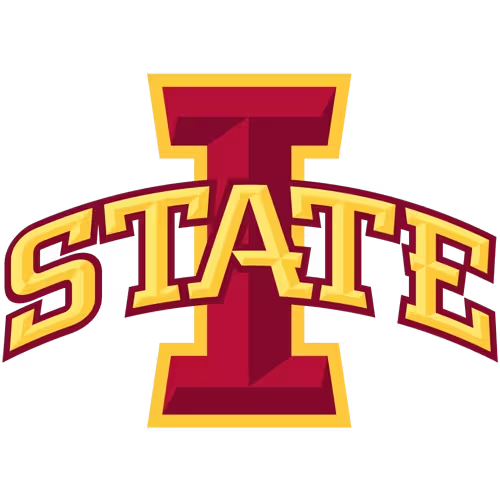
Iowa State Cyclones
The Cyclones could be poised to make a big leap with a win over the hated Hawkeyes. Iowa has dominated this series, but there’s reason to believe the Cyclones’ time is now.
Iowa State has looked extremely good on offense, as star scorer Audi Crooks is having a sensational season (27.1 ppg) for the third-best scoring offense (95.8 ppg) in women’s college basketball.
The Cyclones definitely lean on their star player, but this is obviously a very talented roster offensively, with the team hitting almost 38% of their long-range shots and converting 79% at the charity stripe.
Iowa State isn’t quite as good on the defensive end of the floor, and we saw that firsthand in a wild shootout (106-95) against Indiana in their first Big 10 action of the season.
Head‑to‑Head / Historical Context
There is a ton of history in this Cy-Hawk series. The two Iowa universities have bad blood across numerous sports and enjoy waging war, so this is a huge game even if you remove the Top 25 rankings or long-term implications.
Iowa and Iowa State have battled each other in 54 previous women’s college basketball showdowns, with the Hawkeyes holding a 32-22 series edge. Iowa secured a win in the most recent meeting (75-69) and has dominated overall in recent historyIowa State did break an eight-game run with a 77-70 victory in 2021, and the location of this game has mattered to a degree. The Cyclones are 3-3 in the last six meetings on their home court ,and they’ll again have that advantage on Wednesday night.
Key Matchup Breakdown
This is not the Caitlin Clark-led offense of old. Iowa is still a very good offense (top-20 in points per game), but they’re more balanced and lean on interior scoring more than they have in the past.
Top scorer Ava Heiden (16.1 ppg) is a force as a scorer and rebounder (9.2 ppg), while she’s one of almost four players averaging double figures in scoring. Taylor McCave (9.8) just barely misses the cut, but gives Iowa a rock-solid fourth option.
This is an efficient offense that can work the ball inside and out, with Heiden crushing down low and Chazadi Wright (57%) killing defenses from long range. Wright also quarterbacks this offense (4 assists per game), helping Iowa rank 4th in assists per contest.
The Cyclones are the team built around a Caitlin Clark-type star, as Audi Crooks is a real force inside (27.6 points per game) and also helps out on the glass.
Crooks isn’t hitting shots from deep, but she’s taking on a massive scoring burden and gives Iowa State a nasty threat inside that opposing defenses rarely have an answer for.
That’s helped the Cyclones generate consistently elite offense, as they rank 3rd in scoring and happen to be the third-best shooting team in the nation. They’re getting easy buckets and finding the open girl, too, as Jada Williams (6.7 apg) guides an offense that is averaging the second-most assists on the year.
Addy Brown offers a second interior presence with even better rebounding prowess (9.1 rpg), while she even chips in 1.1 blocks per contest.
The Iowa Hawkeyes have the defensive edge in this game. They rank 22nd in defensive scoring and are nasty on the glass (10th) with 46.4 rebounds per game. Iowa State’s offense will give them problems in this matchup, while they still have the size to compete in the rebounding battle.
Iowa State has the more explosive offense and ranks 2nd in pace of play. The contrast of styles will make for a very interesting matchup on Wednesday night.
- Audi Crooks vs. Iowa’s interior defense: Crooks is putting up over 27 points per game and could feast in this spot. Iowa has size down low, but nobody is quite as strong as Crooks.
- Iowa State’s perimeter defense vs. Chazadi Wright: Wright is shooting a blistering 57% from long range. Iowa State’s pace of play could contribute to a lot of open looks, which could allow her to take over this game from the perimeter.
- Rebounding Battle: Iowa has the edge on the glass, but the Cyclones do have quite a bit of size and only trail the Hawkeyes by four rebounds per game. Who wins the battle of the glass could be huge for this tilt.
Audi Crooks has enjoyed this matchup in the past. She hung 31 and 10 on the Hawkeyes last year and has yet to beat the Hawkeyes in her career. She will be chomping at the bit to change that at home on Wednesday.
Iowa State obviously hasn’t lost yet, but they’ve benefited from playing seven games (7-0) on their home floor. They went 15-2 at home in 2024, too.
Betting Odds
Check out the latest Iowa vs. Iowa State betting odds at FanDuel:
| Team | Spread | Moneyline | Total |
|---|---|---|---|
Iowa | +4.5 (-110) | +154 | Over 150.5 (-106) |
Iowa State | -4.5 (-110) | -192 | Under 150.5 (-114) |
Best Bets & Confidence Levels
| Bet | Recommendation | Confidence Level |
|---|---|---|
Iowa State Cyclones ML (-192) | Iowa has owned this series, but it’s time for the Cyclones to take over. They have the star power and at home, giving them the edge they need to flip the script. | 7/10 |
Audi Crooks Over 25 Points | Crooks is the heart of Iowa State’s team and she’s putting up over 27 points per game. Iowa doesn’t have anyone that can stop her, so she should have no trouble approaching her average in a huge home game. | 7/10 |
Iowa vs. Iowa State odds keep shifting as bettors react to the undefeated showdown — follow every line move, compare spreads and totals, and secure top value at the top sports betting sites.
Final Score Prediction & Closing Thoughts
Final Score Prediction: Iowa State 80, Iowa 75
Iowa State has a stud in Audi Crooks, who can dominate as a scorer inside. She also contributes to the Cyclones’ rebounding efforts and can be an enforcer with 0.9 blocked shots per game.
Crooks isn’t someone Iowa can stop easily, but even if they slow her down, the Hawkeyes still have to worry about Addy Brown, as well as a sharpshooting supporting cast that connects at a near-38% clip from long range.
Iowa defends well and is the more balanced team, but narrative is a thing, and so is home-court advantage. I think the Cyclones win the battle inside, and with the pace pushed a bit faster than Iowa would prefer, they should be able to pull out the win at home.
San Antonio Spurs vs. LA Lakers Prediction & Betting Picks (December 10, 2025)
The 2025-26 NBA Cup rages on, with the San Antonio Spurs and Los Angeles Lakers facing off on Wednesday night. Luka Doncic and the Lake Show enter as -218 betting favorites, but fans and bettors can expect a hard-fought game.
L.A. will be favored by 5.5 points, as Spurs superstar Victor Wembanyama has officially been ruled out. He is officially expected to join the team, but will not play. That said, San Antonio just got Stephon Castle back, so they’re not an easy out even if Wemby isn’t available.
There is a lot at stake for this one, with the winner advancing to the semifinals of the NBA Cup. Let’s look at the latest odds and key matchups and come to a final Spurs vs. Lakers prediction.
Game Details
- Matchup: San Antonio Spurs (16-7) vs. Los Angeles Lakers (17-6)
- Date & Time: Wednesday, December 10th at 9:00 pm (10:00 pm ET)
- Venue: Crypto.com Arena in Los Angeles, CA
- How to Watch: Prime Video, Spectrum Sports Net +, and Spectrum Sports Network
Early Season Performance & Trends
San Antonio Spurs
The Spurs have enjoyed a strong start to the 2025-26 NBA season, going 16-7 through their first 23 games despite battling a litany of injuries.
The biggest one is to star center Victor Wembanyama, who has been sensational when healthy, but has been limited to just 12 appearances. The team also endured some time without star guards De’Aaron Fox and Stephon Castle at different points in the year.

San Antonio is starting to get healthy again, but they obviously will be without their biggest chess piece for both ends of the floor. The Spurs are in good form despite not being at 100%, as they topped New Orleans (135-132) in their last game and are 7-3 over their last 10 games.
Incredibly deep and balanced, the Spurs are a really tough out when at full strength. Even with Wemby sitting this one out, their talent and balance give them a shot against a suspect Lakers defense.
Los Angeles Lakers
The Lakers are even better this year, as they have one more win than the Spurs and one less loss. Los Angeles got off to just a 2-2 start out of the gates, but have put together a stellar 15-4 run ever since.
Much of L.A.’s success has come without legendary point forward LeBron James, who only returned recently and has appeared in just seven games. He’s struggled to regain form since coming back to the starting lineup, but he did deliver a game-winning assist three games ago and exploded for a season-high 29 points in his last outing.
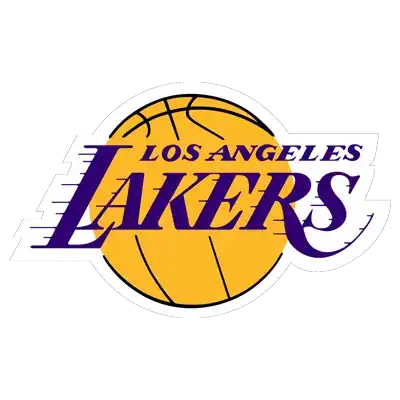
Los Angeles obviously has much more than King James, as Luka Doncic has been amazing in his first full season with the team, while the franchise has unearthed a legit gem with Austin Reaves, enjoying a massive breakout.
The Lakers are currently the second-best team in the Western Conference in terms of record and will look to further show just how good they are in this NBA Cup quarter-finals game.
Head‑to‑Head / Historical Context
The Lakers and Spurs have run into each other 193 times during the regular season and have met an additional 56 times during the NBA playoffs.
For the regular season, the series has been tight, with the Lakers holding a narrow 99-94 advantage. They won the most recent meeting (118-116) back on November 5th and have claimed wins in four of the last five matchups.
L.A. is quite good at home (7-3), and they are 3-1 in their last four home games in this series.
Key Matchup Breakdown
The Spurs have understandably built their offense around Wemby, which has worked out when he’s at full strength. He was quite the force prior to going down with an injury, as he’s averaging over 26 points per game on the season.
Wemby doesn’t have to carry this offense all on his own, of course, as De’Aaron Fox has proven to be a solid Robin to his Batman, while second-year guard Stephon Castle can also pop off as a scorer and create offense for his teammates.
That trio hasn’t spent a ton of time together this year, but the upside is there, and individually they’ve all chipped in to an offense that ranks 7th in scoring and 7th in effective Fg%. San Antonio grades out solidly at the line and from long range, too, making them a multi-faceted offense that is not going to be easy to stop when firing on all cylinders.
The story is similar for the Lakers. They run through Luka Doncic first, but both he and Austin Reaves have been feeding off each other. Doncic paces a strong Lakers offense (10th in scoring) that can infiltrate opposing defenses (11th most points in the paint per game), shoots extremely well (3rd in effective FG%), and knows how to get to the free-throw line.
Doncic (35 ppg) is what makes this team go, but Reaves, LeBron James, Deandre Ayton, and even Rui Hachimura form a strong supporting cast that gives opposing defenses a lot to think about.
Los Angeles is not a high-volume team from outside, but they’re at least middle of the pack in terms of knocking down their threes. The moral of the story? Luka leads an efficient offense that prefers to grind you to a pulp, but leaving their shooters open isn’t necessarily the way to beat them, either.
Both the Spurs and Lakers are methodical on offense and don’t overly rely on the outside shot. This has them grading out as slow teams in terms of pace (25th and 19th), but they still rank inside the top-7 in terms of offensive efficiency.
San Antonio has dropped to 11th in defense, but they were #1 to open the year with Wemby leading the charge. They still rank 9th in defensive efficiency and are allowing the 6th fewest points in the paint.
L.A. is not tough defensively, but they’re not awful. They rank 15th in scoring defense and 19th in defensive efficiency.
- Lakers penetration vs. Spurs interior defense: This is huge for two reasons; the Lakers eat in the paint and get to the free-throw line. On the flip side, San Antonio is tough inside and allows the 6th fewest free throw attempts per game.
- Spurs perimeter offense vs. Lakers perimeter defense: The Lakers are 11th at stopping inside scoring, so the way to beat them is on the outside. The Spurs hit from deep at a 36.6% clip (13th), giving them an edge against the 6th-worst three-point shooting defense in the NBA.
- Spurs transition game vs. Lakers transition defense: San Antonio ranks 12th in fastbreak points per game, and the Lakers are terrible (26th) at defending the break. With Wemby still sidelined, this is a matchup where the Spurs can thrive.
Wemby has already been officially ruled out for this game. His absence hurts San Antonio’s defense and takes a 26-point-per-game scorer off the table.
Marcus Smart (back) is slated to return for this contest. He’s been out since November 25th and will be a boost for L.A.’s perimeter defense.
Betting Odds & Market Interpretation
Check out the latest Spurs vs. Lakers betting odds at DraftKings:
| Team | Spread | Moneyline | Total |
|---|---|---|---|
Spurs | +7.5 (-115) | +225 | Over 238.5 (-110) |
Lakers | -7.5 (-105) | -278 | Under 238.5 (-110) |
The Lakers are reasonable favorites at home, largely due to the home-court edge and being healthier right now. It’s a little surprising the Spurs aren’t bigger underdogs with Wemby ruled out.
The game total feels pretty high given San Antonio’s solid defense and the slower pace of play for both teams.
From a Bettor’s Lens
Wemby’s absence hurts the odds of the Over delivering, while he would have also improved San Antonio’s chances of pulling off the upset.
The game total feels trappy. Both teams can put up points, but the Spurs are strong defensively, and neither team is reliant on the outside shot.
Situational Considerations
This is not a regular game, as it’s the quarter-finals of the NBA Cup. Both teams will want to win this game and won’t rest anyone that isn’t seriously injured.
This game is also in L.A. The Lakers are 7-3 at home, while the Spurs are just 7-5 away from home.
Best Bets & Confidence Levels
| Bet | Rationale | Confidence Level |
|---|---|---|
LA Lakers ML (-278) | The Lakers are the 2nd best team in the Western Conference, they are at home, the Spurs are without Wemby, and a trip to the NBA Cup semifinals is at stake. I expect the Lake Show to show up and get the job done. | 8/10 |
Spurs ATS +7.5 (-115) | While the Lakers are a good bet to win this game, the Spurs are not chopped liver. They have still been very competitive without their top player. For what it’s worth, they are a solid 5-3 against the spread, too. | 7/10 |
Prop Play – Luka Doncic Over 30+ Points (-179) | Luka hits this mark in his sleep. You could target a higher point total, but this is as close to a gimme pick as it gets, barring a blowout. | 8/10 |
Line movement for Spurs vs. Lakers is heating up — monitor shifting odds, watch for price drops, and secure your edge at our trusted sportsbooks.
Final Score Prediction & Closing Thoughts
Final Score Prediction: Lakers 115, Spurs 112
We now know that Wemby will not be available for this game. Due to that, my main Lakers vs. Spurs prediction is an L.A. win. I also acknowledge the fact that the Spurs can compete without him, so I like San Antonio’s chances to give the Lakers a run for their money.
Still, the Lakers are the better team right now, they’re at home, and getting to – and possibly winning – the NBA Cup title game could be a huge confidence booster for this squad. L.A.’s moneyline is safe, but not super appealing at -218, which is why I am including two more Spurs vs. Lakers picks I am high on.
Whether I’m right about that or not, Luka Doncic is a really good bet to top 30+ points. He is averaging 35 points per game on the year and has topped this mark in eight straight games, as well as 13 different times on the season.
Could Kalshi Make DraftKings Obsolete? The Shocking Legal Battle Explained
Imagine waking up one morning in early 2026 and seeing a headline that doesn’t seem real:
“DraftKings Plunges 50% Overnight After Federal Court Ruling.”
No major game-fixing scandal.
No tax hike.
No meltdown in parlay revenue.
Just one trigger: Kalshi — a prediction market barely anyone outside the finance world knew three years ago — wins a landmark lawsuit against state regulators.
Suddenly your parlay app stops working in half the country. Bonuses vanish. Same-game parlay menus shrink. DraftKings and FanDuel are scrambling to explain a future where they no longer control the betting landscape… because a federally regulated “event-contract exchange” just rewrote the rules of the entire industry.
This isn’t science fiction.
It’s exactly what Connecticut hinted at on December 3rd, 2025, when the state issued cease-and-desist orders against Kalshi, Robinhood, and Crypto.com for offering what they called “unlicensed sports betting.” Kalshi fired back within hours with a federal lawsuit claiming the state has zero authority to regulate them. And underneath that fight is a single, explosive question:
Does the CFTC — a federal commodities regulator — actually have full jurisdiction over sports-related “event markets”… overriding every state gambling law in America?
If the courts say “yes,” DraftKings’ empire evaporates overnight.
- No more state-by-state licensing moat
- No more geo-fencing
- No more 51% tax brackets
- No more parlay margins insulated by regulation
A Kalshi victory wouldn’t just hurt DraftKings — it could federalize sports betting, choke off billions in state gambling revenue, and hand control of the industry to a low-fee disruptor that treats betting like stock trading.
And as insane as it sounds… Wall Street already showed us a preview. When Kalshi launched its parlay-style sports markets in September 2025, DraftKings and Flutter lost $7 billion in combined market cap in a single day.
This article breaks down exactly how we got here, who’s right in the legal war, why DraftKings is far more vulnerable than anyone thinks, and what smart bettors should do right now to prepare.
What the Hell Is Kalshi, Anyway?
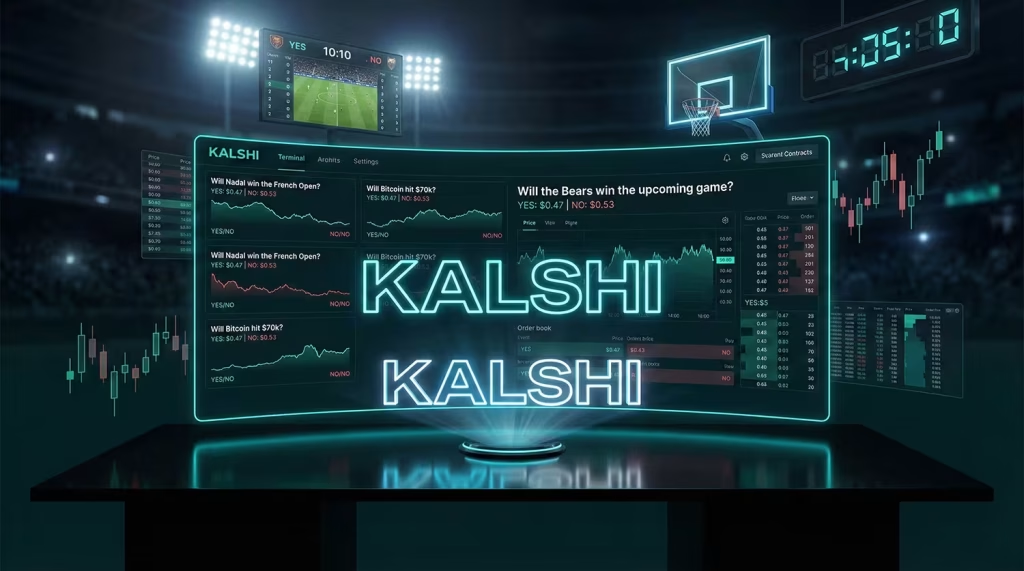
Most bettors first heard the name Kalshi sometime in 2024 or 2025, usually from someone saying, “It’s like betting… but it’s not betting.” And that confusion isn’t accidental — Kalshi built its entire empire on exploiting a regulatory definition that’s older than the internet.
Let’s break it down without the legal jargon.
From Election Bets to Sports Domination
Kalshi launched in 2021 as a CFTC-designated contract market — basically a federally regulated exchange where people trade “yes/no” contracts about real-world events.
- Will inflation be above 3.5% this month?
- Will Congress pass a shutdown bill?
- Will Bitcoin close above $100k?
Each contract trades between $0.01 and $0.99 and settles at $1 if it happens — or $0 if it doesn’t. It’s trading, not a sportsbook. There’s no oddsmaker, no house line, no parlay boosts. Kalshi simply matches buyers and sellers and charges a tiny fee (usually 0.5–1%).
No vig.
No juice.
Just fees.
In early 2025, Kalshi made its boldest move yet: it self-certified sports markets with the CFTC. And that single decision changed its entire trajectory.
Within months, sports exploded to 90% of Kalshi’s total volume, peaking at $728 million in weekly trading during September 2025.
March Madness alone? Over $500 million traded. Equivalent to 16% of U.S. sportsbook handle — with a fraction of the marketing spend.
Kalshi didn’t just add sports…Sports became the business.
The Sports Betting Trojan Horse
The clever part is this: Kalshi never advertised itself as a sportsbook — even though users were clearly treating it like one.
- Next TD scorer
- First basket
- Team moneylines
- Player micro-events
- Win margins
- Same-event combinations that function like parlays
Kalshi offered all of it, wrapped in the language of “event contracts.”
To regulators, that’s a gray area. To bettors, that’s a dream come true.
Here’s why bettors flocked to Kalshi fast:
Why Bettors Love It
- Better implied odds (no vig)
- Nationwide access if Kalshi wins its case
- Transparent markets where you see real prices move
- No house advantage — it’s peer-to-peer trading
- Micro-events that feel like the next evolution of prop betting
Why Regulators Hate It
- It looks like sports betting
- It acts like sports betting
- But it’s technically not licensed as sports betting
- And states can’t tax it (that’s the real problem)
Kalshi didn’t break in through the front door. It walked right through an unattended side entrance the government forgot to lock.
The Billion-Dollar Billionaire Behind It
Kalshi’s rise isn’t an accident — it’s engineered by Luana Lopes Lara, the charismatic co-founder who became the youngest self-made female billionaire in America, surpassing even Taylor Swift in net worth growth charts.
Her strategy is crystal clear: Make event trading mainstream.
- Partnerships with major media outlets
- A December 2025 integration with CNN
- Viral X threads arguing event markets improve democracy
- A cult-like community defending Kalshi online
Whenever Lara posts, replies fill up with people saying things like:
“Kalshi is going to replace sportsbooks.”
“Opinions now have value — this is the future.”
“States are scared because they can’t tax this.”
And honestly… they’re not wrong.
Kalshi isn’t fighting over semantics. They’re fighting for the legal right to dominate sports betting nationwide under federal law.
And that legal war has now spilled into multiple courtrooms — which brings us straight to the next section.
The Lawsuit Lowdown: Kalshi’s Federal Power Play
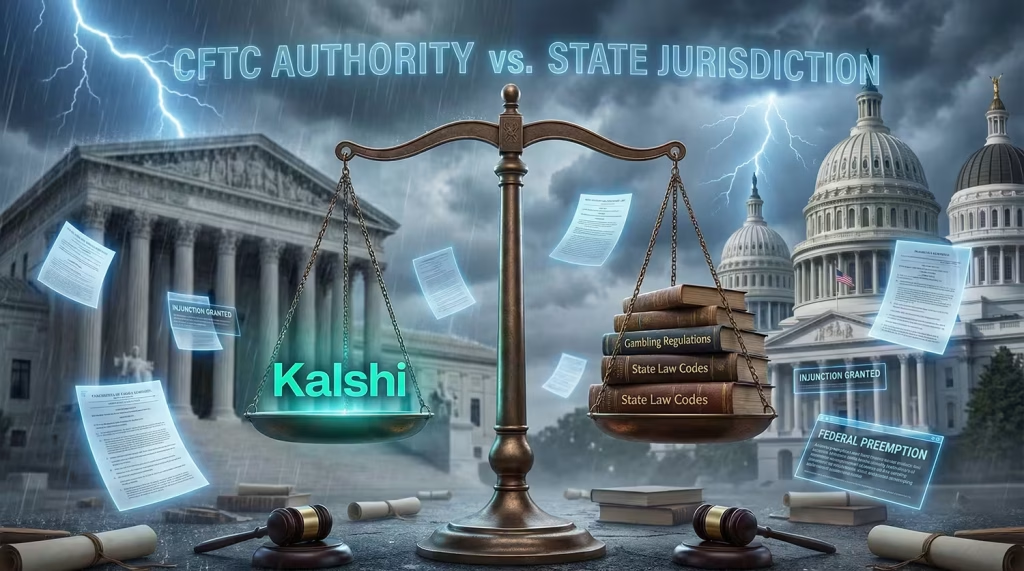
If Kalshi is the disruptor, the lawsuits are the detonator. This entire battle comes down to one argument so simple you can summarize it in a single sentence:
Kalshi says the federal government regulates them — and states have no right to interfere.
States say: “Nice try. This is sports betting. That’s our turf.”
Who’s right? That answer could rewrite U.S. gambling law for the next 50 years.
Let’s break this down piece by piece.
The Core Battle: CFTC Preemption vs. State Gambling Laws
At the heart of the fight is the Commodity Exchange Act (CEA) — a federal law that gives the CFTC exclusive authority over designated contract markets (DCMs), which Kalshi legally is.
Kalshi’s claim is bold:
“If we’re a federally approved exchange, no state can ban or regulate our event contracts. Sports, politics, weather — all of it falls under federal jurisdiction.”
States — 11 of them and counting as of December 2025 — disagree loudly:
“Event contracts = gambling. Gambling is regulated by the states. End of story.”
This tug-of-war erupted into a frenzy of rulings, injunctions, and contradictory decisions.
Here’s the landscape so far:
Key Flashpoints (2025)
Nevada — November 2025
Judge Andrew Gordon dissolves Kalshi’s injunction and rules Kalshi must comply with state gaming laws. DraftKings and FanDuel stocks immediately jump 5%.
This ruling terrified Kalshi: if Nevada could regulate them, other states could copy.
New Jersey — May 2025
Opposite outcome. Kalshi wins a preliminary injunction, with the court signaling that federal preemption may apply.
This was the first hint the legal tide wasn’t one-sided.
Connecticut — December 3, 2025
The most aggressive move yet. Connecticut sends cease-and-desist letters to:
- Kalshi
- Robinhood
- Crypto.com
…accusing them of unlicensed sports betting.
Kalshi responds instantly with a federal lawsuit, arguing:
- Connecticut is violating the U.S. Constitution
- Kalshi will suffer “irreparable harm”
- CFTC jurisdiction overrides the state entirely
This case may become the precedent-setter the entire country follows.
User Class Action — November 2025
Seven New York users sue Kalshi for “misleading advertising” around legality and accuse the company of secretly acting as “the house” through market-making mechanisms.
If proven, that would undermine Kalshi’s whole pitch: “We’re not a sportsbook.”
One viral X thread from @FundamentalLack sums up the mood:
“If Kalshi is market-making on sports, they’re not an exchange — they’re a sportsbook pretending to be a brokerage.”
The Do-or-Die Stakes
Here’s the actual nightmare scenario for DraftKings: If Kalshi wins these lawsuits, they become available nationwide — not 25 states, not 30 states, but all 50. Even to 18-year-olds.
No licenses.
No taxes.
No $100 million market-access deals like DraftKings pays.
No state-by-state approvals.
No 51% tax brackets like New York.
Their pricing becomes unbeatable.
The timelines are real:
- 2026: Injunctions and appeals
- 2027: Federal appellate split likely
- 2027–2028: Supreme Court almost guaranteed to weigh in
And the CFTC? Their April 2025 roundtable showed surprising warmth toward event markets, hinting they might support Kalshi long-term.
X Pulse: The Social Firestorm
Sports bettors and finance nerds are melting down on X as this plays out. A quick snapshot:
- @salmanso_: “Kalshi hate is interesting… opinions now cost something.”
- @Tampa2CFB questioning CNN’s integration: “They’re partnering in the middle of a lawsuit? Bold.”
- @datasaurusREKT: “If Kalshi wins, DraftKings is cooked. Real talk.”
These posts matter because they reveal a shift: For the first time, sports bettors think a fintech exchange might replace traditional sportsbooks.
Kalshi isn’t trying to carve out a niche; they’re trying to redefine the entire category — not “sports betting,” but “sports trading.”
And DraftKings? Their whole empire depends on the walls Kalshi is trying to tear down.
DraftKings’ House of Cards: Why They’re Screwed
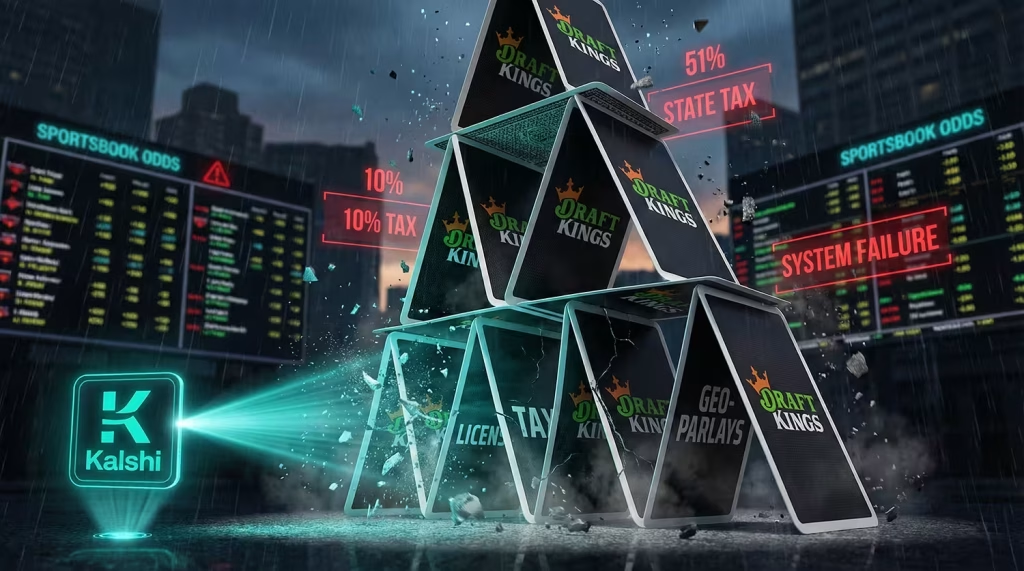
DraftKings isn’t just vulnerable — it’s structurally exposed. Everything that makes DraftKings a powerhouse today is the exact thing Kalshi is trying to blow up.
And if Kalshi wins its federal preemption fight, DraftKings faces a threat far more dangerous than competition:
A world where DraftKings’ business model no longer makes sense.
Let’s break down the three biggest pressure points.
1. The Licensing Shackles DraftKings Can’t Escape
DraftKings lives and dies by state-by-state licensing.
- They’re live in 25 states + DC
- They pay $100M+ in market-access deals across the country
- They’re taxed between 10% and 51%, depending on the state
- They spend hundreds of millions lobbying legislators
- They employ teams of lawyers to maintain compliance in every jurisdiction
This is why DraftKings trades like a regulated monopoly — the barriers to entry are massive.
But if Kalshi wins?
All those walls become useless.
Kalshi would operate:
- In all 50 states
- Without geo-fencing
- Without license caps
- Without state oversight
- With nearly zero tax burden
- Even for age 18+, not 21+
DraftKings’ moat disappears overnight.
Two states make this especially deadly:
California and Texas
DraftKings is essentially locked out of them.
Kalshi wouldn’t be.
California alone is a $20B+ sports betting opportunity — DraftKings has fought for years to enter and failed.
Kalshi could walk right in through a federal loophole.
2. Revenue Rockets Pointed Right at Sportsbooks’ Weakest Spot: Parlays
DraftKings’ entire revenue engine depends on one thing:
Same-game parlays.
- Over 50% of handle
- Over 60% of revenue
- House edge in double digits
- Biggest reason DraftKings posts huge margins in football season
Kalshi threatens this in two ways:
❶ Better Pricing
Kalshi has no vig.
No juice.
No sportsbook margin.
If a parlay-like outcome should be 50/50, Kalshi traders will price it near 50/50 — not -120/-120.
For sharp bettors?
This is Christmas morning.
❷ A Real-Time Proof of Concept
When Kalshi launched parlay-style sports markets in September 2025:
- DraftKings stock crashed 11.6%
- Flutter (FanDuel) lost billions
- $7B in combined market cap vanished in one trading session
All from a small-scale launch with tiny fees.
Imagine that effect if Kalshi is live nationwide, competing on price with models that sportsbooks literally cannot match.
DraftKings can’t lower prices — the state tax burden is too high.
Kalshi doesn’t have that problem.
3. The Addiction & Integrity Trap That Backfires on DraftKings
States depend on DraftKings and FanDuel for tax revenue. They also depend on them for:
- Problem-gambling funding
- Integrity monitoring
- AML compliance
- Responsible gaming programs
Kalshi sidesteps these obligations by calling the activity “trading.”
To states, that looks like:
- Lost tax revenue
- Lost control
- Increased risk of untracked betting
- Undermining regulatory authority
This is why 34 states joined an amicus brief against Kalshi in June 2025.
DraftKings didn’t even have to lobby for it — states fought on their behalf.
But here’s the twist:
If Kalshi wins anyway, it means states lost the one fight they cared about most.
DraftKings would instantly become:
- A high-tax operator in a low-tax market
- A geo-fenced app competing with a nationwide exchange
- A legacy sportsbook with costs 10X higher than the disruptor
They can’t win that pricing war.
Not today.
Not in 2027.
Not ever.
A Kalshi victory isn’t just competitive pressure. It’s a category collapse for DraftKings.
Their biggest strength — state regulation — becomes their biggest weakness. Their most profitable product — parlays — becomes impossible to defend. And their largest stakeholders — the states — may lose the fight completely.
The Apocalypse: 3 Doomsday Scenarios for DraftKings

If Kalshi wins its federal battle, DraftKings doesn’t just take a hit. It faces a fundamental unraveling of its business model — one that plays out in waves. Here are the three most realistic “doomsday” scenarios, based on current market structure, state tax dependencies, and Kalshi’s volume trajectory.
Scenario 1: Market Cannibalization (Short-Term, 2026)
DraftKings loses $1 billion in revenue within 12 months.
This is the immediate-cut scenario.
- Kalshi becomes available nationwide (or close enough through injunctions).
- Sharp bettors migrate first — props, micro-events, and parlay-adjacent trades flow to the cheaper exchange.
- Casual bettors follow once TikTok and X start comparing DraftKings’ -120 parlays to Kalshi’s 50/50 prices.
DraftKings loses:
- High-margin parlays
- Prop bettors
- Customer time spent
- Conversion on boosts and promos
DKNG stock dips 20–30% as Wall Street models in reduced hold percentages.
FanDuel takes friendly fire.
Scenario 2: Regulatory Reckoning (Mid-Term, 2027)
State taxes collapse — and DraftKings is forced into a model it cannot sustain.
If courts rule that the CEA preempts state sports betting laws:
- States lose billions in tax revenue
- Regulators panic
- Legislatures attempt “emergency bills” to regain control
- DraftKings gets dragged into costly compliance rewrites
Possible dominoes:
- Mandatory lower vig
- Forced exchange-style pricing
- Retroactive audits
- Pressure to pivot into CFTC-style structures
And here’s the killer: DraftKings needs state taxes to remain high because that keeps competitors out. Kalshi needs low taxes — or no taxes — to win.
If states can’t fight back, the entire regulatory framework breaks.
DraftKings becomes an expensive relic trying to survive in a low-fee, federally governed ecosystem.
Bankruptcy risk? Not impossible — especially if California legalizes Kalshi-first and DraftKings watches a $20B market bypass them entirely.
Scenario 3: Total Disruption (Long-Term, 2028+)
Prediction markets swallow 40% of the U.S. betting industry.
This is the “Blockbuster vs. Netflix” arc.
- Kalshi reaches a multibillion-dollar valuation
- Liquidity snowballs, making markets even more efficient
- Fox, CNN, ESPN start integrating event prices into broadcasts
- Retail bettors become “event traders” instead of parlay players
DraftKings still exists — but as a legacy sportsbook, not the industry leader.
MGM adapts.
FanDuel pivots into casino.
DraftKings becomes the dinosaur.
One ARK Invest analyst’s quote from 2025 rings loud:
“If Kalshi wins jurisdiction, DraftKings becomes the AOL of betting.”
Optional Scenario 4: The Hybrid Death Spiral (2027–2029)
DraftKings tries to create its own exchange… and fails.
They acquire Railbird.
They launch a DraftKings Exchange.
They try to mimic Kalshi.
But without:
- Kalshi’s liquidity
- Kalshi’s regulatory position
- Kalshi’s pricing model
…it never catches on.
DraftKings ends up running two conflicting businesses: a taxed sportsbook and an uncompetitive exchange.
The result? A decade-long decline.
What Bettors & Investors Need to Do NOW
If Kalshi wins its legal war, the landscape of betting — and investing — changes fast. You don’t want to be reacting when everyone else already moved.
Here’s what smart bettors, investors, and industry watchers should be doing right now.
For Bettors: Hedge, Test, and Prepare
Don’t abandon DraftKings yet — but don’t keep all your betting activity in one place either.
1. Test Kalshi’s Markets Now
Get familiar with:
- Micro-events
- Market depth
- Price movement
- Volume patterns during NFL games
If Kalshi goes nationwide, you’ll already be ahead of the curve.
2. Exploit Price Inefficiencies
Right now, there are moments where:
- DraftKings props are -120/-120
- Kalshi equivalent markets trade around 50/50
That gap = instant value.
3. Use DraftKings Bonuses Strategically
If DraftKings feels pressure, promotions will spike. Use them to boost ROI in the short run.
For Investors: Watch the Legal Signals Like a Hawk
This market isn’t about emotions — it’s about catalysts.
Key Signals to Track
- Connecticut injunction ruling (Q1 2026)
- Any multi-state coordinated action against Kalshi
- Second Circuit or D.C. Circuit appeal movements
- CFTC public statements (especially around “event markets”)
- Liquidity surges on Kalshi during major sports windows
A single ruling could swing DKNG double digits in one day.
Positioning Ideas (Not Financial Advice)
- Some traders see DKNG as a short candidate if courts lean toward Kalshi
- Others prefer playing volatility
- And some are quietly building positions in event-market competitors like Polymarket, especially with their DeFi reroute
The point isn’t picking a side — it’s understanding the stakes.
This lawsuit is moving fast, and bettors who stay plugged in will benefit first.
Conclusion: The End of an Era?
DraftKings isn’t staring down a competitor. It’s staring down a legal earthquake that could tear apart the foundation of its entire business. Kalshi’s lawsuit isn’t a headline for industry nerds — it’s a direct challenge to the state-regulated, high-tax sportsbook model that DraftKings has relied on for dominance.
If Kalshi wins, the shift is instant and brutal:
- Sports betting becomes federal, not state-controlled.
- Prices move from “house odds” to transparent market trading.
- Parlays — DraftKings’ golden goose — bleed volume to low-fee exchanges.
- State tax revenue collapses.
- And DraftKings wakes up competing against a nationwide platform with no licensing burdens, no geo-fencing, and a structure they simply cannot match.
This isn’t overstatement. The September 2025 market shock showed exactly how fragile DraftKings becomes the moment someone prices bets more efficiently.
Kalshi doesn’t need to destroy DraftKings to win. It just needs to prove that event markets are a federal product — not a state one.
And if that happens? DraftKings won’t fall overnight…But it will fall predictably.
Illinois vs. Ohio State Basketball Prediction (December 9, 2025)
The Illinois Fighting Illini get their first taste of 2025 Big 10 action on Tuesday night, where they will be 4.5-point favorites to take down the Ohio State Buckeyes.
Illinois is a solid 7-2 to start the year, as they have looked very sharp on offense as a whole. They’ll be tested in this one, as they’ll be on the road in a hostile environment against a good Ohio State squad that is 7-1 so far.
Big 10 games are always tough to gauge, but this is a huge early-season battle, with it being Illinois’ first game inside conference play. I’ll inspect the latest odds and key matchups as I work my way to my favorite bets and Illinois vs. Ohio State prediction.
Game Details
- Matchup: Illinois Fighting Illini (7-2) vs. Ohio State Buckeyes (7-1)
- Date & Time: Tuesday, December 9th, at 6:30 pm (7:30 pm ET)
- Venue: Jerome Schottenstein Center in Columbus, OH
- How to Watch: The game will be broadcast on Peacock
Early Season Performance & Trends

Illinois Fighting Illini
You know the Illini are good since they have two losses already and are still ranked 13th in the college basketball Top 25. The losses aren’t anything to worry about, though, as they fell to a good UConn program. Their other loss was by four in a wild 90-86 shootout with a good Alabama team.
Overall, Illinois looks good. They bounced back from the loss to the Huskies by dismantling the Tennessee Volunteers (75-62) last time out, and they’ve flashed crazy upside with 80+ points in seven of their games. They’re 6-1 in such contests.
The Fighting Illini have yet to be tested in a true road game, however. Both of their losses came on neutral courts, so Tuesday’s showdown with Ohio State represents both their Big 10 season opener and their first true road game of 2025.
They enter this game ranked inside the top-20 in scoring, but have not been quite as impressive on the defensive end of the floor.

Ohio State Buckeyes
The Buckeyes are off to a terrific 7-1 start, and they knocked off Northwestern in a crazy 86-82 thriller to begin their Big 10 journey at 1-0. That saw them bounce back from a tough 67-66 loss to Pittsburgh, which presently grades out as a bad loss.
That plays into Ohio State not currently being ranked inside the Top 25 for college basketball, but they still have a strong overall record and have exhibited top-shelf offensive ability in almost every other game.
On the year, the Buckeyes are not far behind Illinois in scoring (27th), while they have similar defensive limitations. Due to the home court edge against a team they know well, they stand out as an interesting value bet.
Head‑to‑Head / Historical Context
This is an extremely storied rivalry, with these two sides facing off on the hardwood 195 times throughout history. The Fighting Illini hold a 113-82 advantage in the series and won the most recent meeting (87-79) back in February.
Illinois is currently on a three-game winning streak in the series, while they are 6-4 against the Buckeyes over the last 10 matchups.
Ohio State has held the upper hand at home, going 50-44 in 94 meetings on their home court. They’ve been great at home this year so far, too, going 6-0 outside of Big 10 play.
Key Matchup Breakdown
The Fighting Illini rebound the ball extremely well, dominate inside, and put up plenty of volume from long range. That inside/outside game allows them to put up 88 points per game, with forward David Mirkovic (13.7 ppg, 9.5 rpg) doing as he pleases inside.
Mirkovic delivered one of his best games against Colgate, where he abused them inside for 27 points and 21 rebounds. He’s just one piece to the puzzle, of course, as Kylan Boswell (17 ppg) and Andre Stojakovic (14.8 ppg) also chip in with strong scoring, while Tomislav Ivisic and Keaton Wagler offer timely outside shooting (both connecting on over 34% of threes).
Big man Zvonimir Ivisic only plays 18 minutes per game, but chips in over seven points and five rebounds per game, while also being a menace inside with 2.5 blocks per contest.
It’s a balanced offensive attack that will crush you inside, but has the ability to also burn you from deep.
The Buckeyes are led by star guard Bruce Thornton, who puts up 20.1 points per game and even leads the team with 4.3 assists per contest. He’s been extremely consistent all year, scoring in double figures in every single game so far, but also displaying his ceiling with 38 points two games ago.
Ohio State is more than just one guy on offense, as this team has the 7th-best effective FG% in all of college basketball. This is far from a one-man show, as the Buckeyes share the ball with the best of them (41st most assists per game) and generate over 88 points per contest.
In addition to Thornton’s reliable scoring, three other Buckeyes put up over 13 points per game, with the team as a whole making defenses pay from long range (36.9%) when left open.
This team is about efficiency, working the ball inside, and finishing, however. Ohio State connects on the 35th most free throws per game, while nobody is better at shooting inside.
Neither of these teams play particularly fast. The Buckeyes are the faster-paced between the two (149th), while Illinois is far slower (200th).
Both Illinois and Ohio State are decent defensively, given their offensive production, but both are giving up 69 points per game.
Illinois struggles to defend the three, but they are making life difficult on teams inside (25th lowest two-point percentage allowed. The Buckeyes are especially nasty on the glass (30th), while they are also extremely stingy out on the perimeter (11th).
- Illinois’ perimeter offense vs. Ohio State’s defense: The Fighting Illini like to get up 29 threes per game, and rely on that volume to generate production. They may run into a snag against the Buckeyes, who defend the outside as well as anyone (11th).
- Ohio State’s interior scoring vs. Illinois’ interior defense: This will be a very interesting matchup, as the Buckeyes are #1 in two-point shooting and are one of the most efficient offenses in college ball. However, the Illinois defense is also 39th in shooting efficiency, allowing the 26th-lowest two-point shooting percentage.
- Free Throw Battle: The team that can get to the line more may end up winning this game. Both of these teams convert freebies at a 77% clip, but it’s the Buckeyes who rank 35th in free throw makes per game because they’re better at getting to the charity stripe.
Ohio State has been great at home and already has tasted victory inside the Big 10. The visiting Fighting Illini will be playing their first Big 10 game of the year and their first true road game of the season.
Betting Odds & Market Interpretation
Check out the latest Illinois vs. Ohio State betting odds at FanDuel:
| Team | Spread | Moneyline | Total |
|---|---|---|---|
Illinois | -4.5 (-102) | -192 | Over 157.5 (-115) |
Ohio State | +4.5 (-120) | +158 | Under 157.5 (-105) |
The Fighting Illini come in as almost four-point road favorites, which tells you how the oddsmakers view these two teams. That’s a surprising spread and moneyline considering they are on the road, but they are viewed as the superior team.
The game total is pretty modest, but for college basketball, it’s toward the higher end. That plays into two very gifted offenses. Both teams have respectable defenses so far, but they’re both giving up almost 70 points per game and scoring 88, each.
From a Bettor’s Lens
The obvious betting value lies with the Buckeyes. It’s arguable that Illinois is the better team, but they’ve also lost two games already and have to play a rival on the road.
The game total seems targetable based on the offensive production to this point, too. These teams are averaging a combined 176 points per game.
Best Bets & Confidence Levels
| Bet | Recommendation | Confidence Level |
|---|---|---|
Under 157.5 (-105) | I respect the offenses from both sides, but the Illinois defense in particular has flashed real potential. Neither of these teams plays all that fast, and the Ohio State perimeter defense could be problematic for Illinois on the outside. | 7/10 |
Ohio State ATS +4.5 (-120) | The Buckeyes have looked good, and they are at home, where they are tough to beat. They have a legit star scorer in Thornton, and their perimeter defense could pose a real problem for an Illinois team that likes to hoist a good amount of treys. Ultimately, getting 3.5 points feels good. | 6/10 |
Shifting odds reflect bettors reacting to Illinois vs. Ohio State’s offensive firepower and road-court concerns—track every updated betting line at the top sports betting sites.
Final Score Prediction & Closing Thoughts
Final Score Prediction: Illinois 73, Ohio State 70
I think we’re in for a barn burner. These defenses are a bit suspect, this is a rivalry game, it’s a tone setter for both sides, and both offenses can ball.
Bruce Thornton is having himself a season. He is shooting an insane 52% from long range and doing a little bit of everything for Ohio State. He doesn’t get a ton of high-level help from the guys around him, but Ohio State collectively can still hit their threes, and they know how to get to the line.
Illinois is going to show up when looking at grit, interior play, and outside volume. Ohio State has the edge in perimeter defense, star power, and home-court advantage. I think that’s enough to get me to pull the trigger on the Buckeyes to beat this spread.
I do fear the Fighting Illini defense, as they stifled Tennessee in their last win. They are also a deeper and more balanced team. Thornton and playing at home allow Ohio State to make Illinois sweat and beat the spread, though.
Miami Heat vs. Orlando Magic Prediction & Betting Picks (December 9, 2025)
Welcome to the quarter-finals of the 2025 NBA Cup, where the 4-seeded Miami Heat will take on the 1-seeded Orlando Magic on Tuesday. Orlando already owns a 2-0 season series lead against the Heat, and are fresh off of a tight 106-105 win from two games ago.
Miami will still enter this showdown with an eye on the prize, and they’ll even be slight -118 favorites to get the job done. They’ll have to do it on the road and could be without some key bodies, however, but their pace of play also promises to make this a lively affair (237.5 game total).
So, who will advance to the NBA Cup semifinals? Let’s look over the latest odds and key matchups as I get to my preferred picks and ultimate Heat vs. Magic prediction.
Game Details
- Matchup: Miami Heat (14-10) vs. Orlando Magic (14-10)
- Date & Time: Tuesday, December 9th at 5:00 pm (6:00 pm ET)
- Venue: Kia Center in Orlando, FL
- How to Watch: Amazon Prime Video
Early Season Performance & Trends
Miami Heat
The Heat just suffered their first three-game losing streak of the year. They’ve been up and down all season, but they were running hot with a 7-1 mark in their previous eight games before this slide.
Miami’s 14-10 run to this point is pretty impressive considering Jimmy Butler left the team via trade last year. On top of that, they’ve only had star guard Tyler Herro on hand for five games.

The Heat have gotten by with a breakneck pace, as they push opposing teams to the point of exhaustion and run up the points. It has led to the league’s 3rd best scoring offense and top finishes in key categories, and while their recent form is suspect, they now have a chance to win the NBA Cup.
Orlando Magic
The Magic have the same exact record as Miami (14-10) and presently sit ahead of them in the Southeast Division. The winner of this game would take over the top of the division, while simultaneously locking up the fifth-place seed in the Eastern Conference for the moment.
There hasn’t been much evidence that either of these teams are ready to ascend to an elite level, but they are merely two wins from second place in the conference.
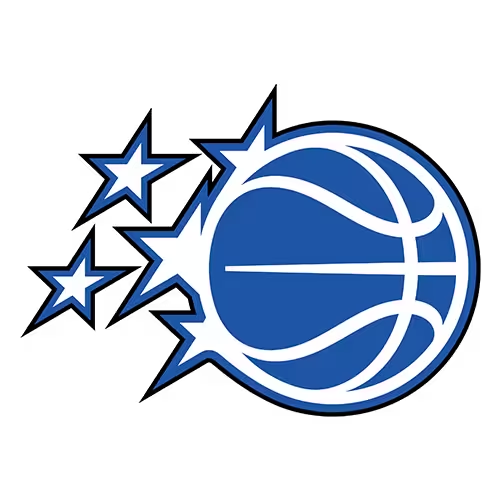
Orlando isn’t as fast or as flashy as the Heat. They have a capable offense with some notable star power, but much like Miami, they’ve been forced into a lot of action at less than full strength. Forward Paolo Banchero specifically has missed 10 games on the year.
Despite that fact, the Magic have been incredibly balanced, approaching the top-10 in offensive scoring and holding strong at 7th in defensive scoring. And just like Miami, they now have a shot at claiming the NBA Cup.
Head‑to‑Head / Historical Context
Miami and Orlando know each other pretty well, playing inside the Southeast Division. They just played each other two games ago, with the Magic pulling out a tight 106-105 win.
That gives the Magic a 2-0 series edge on the season, while they’re now down 81-63 in the all-time series. Tuesday’s meeting is even more intense than normal, of course, as it’ll be in the quarter-finals of the 2025-26 NBA Cup tournament.
Key Matchup Breakdown
The Heat are all about pace, as they work hard to burn out the opposition, while racing down the floor to get easy buckets. That’s led to the third-most points per game, the third-most fastbreak points per game, and the second-most points in the paint.
Miami is not a high-volume offense from deep. They want efficiency, and they want accuracy. They shoot 48% overall (11th) and 37.4% from long range (6th) despite not being a high-volume three-point shooting offense. They are getting the ball inside, and when they shoot a three, it’s usually one that is open.
This offense can excel with or without Herro. It did so for much of the year, and has weirdly only run into trouble since his return. A big reason for Miami’s success has been the career-year out of veteran swingman Norm Powell (25 ppg), while they’ve gotten solid production out of Bam Adebayo, Andrew Wiggins, and Jaime Jacquez as well.
Miami’s kryptonite is a team that can slow down the pace, defend the paint, and/or close out on the outside. Orlando’s been pretty good at most of that, which makes it no surprise Miami has yet to take them down this year.
Orlando is pretty dependent on their top isolation scorers, usually turning to Franz Wagner and Paolo Banchero to initiate and execute offense. Both are good at penetrating defenses, but also have solid mid-range games that extend out to the three-point line.
The bad news is now two-fold. Banchero has missed a ton of time, and now Wagner is injured and won’t be able to suit up for this game. Banchero’s absence had placed a lot of pressure on Wagner, and now that responsibility will be flipped.
Luckily, Banchero isn’t totally alone. Despite a slow start with his new team, Desmond Bane has been heating up in recent weeks. His perimeter offense can feed off of Banchero’s, while two-way ace Jalen Suggs can hurt teams from long range as well.
Orlando’s offense isn’t really suited to run with Miami. However, if they slow down the pace and execute like they did in the most recent game, their more methodical offense could win out (again).
It didn’t work out as planned in the last meeting, but the Heat typically play a very fast-paced brand of basketball. They presently rank #1 in pace, but despite the amount of possessions they force on their opponents, they’re still quite efficient (2nd) on defense.
Orlando isn’t nearly as fast, ranking 21st in pace. They’re a strong defensive team, however, as they rank 5th in efficiency and also allow the 10th fewest points per game.
- Miami’s three-point shooting vs. Orlando’s perimeter defense: The Heat push the pace and get all kinds of good looks. They rely more on converting good looks than volume, but Orlando allows the fewest three-point attempts in all of basketball.
- Orlando’s penetration vs. Miami’s interior defense: The Magic are down an elite penetration scorer in Wagner, so it will be interesting to see if they can score inside as effectively. They’re also used to getting to the free-throw line at will, but could miss Wagner’s 6.8 free-throw attempts per game.
- Battle in Transition: These are two very good teams on the break. Orlando can struggle in a half-court setting, so they’re even more reliant on finishing in transition. Not having a key scorer like Wagner could hurt their chances of winning the fastbreak battle.
Both teams could be banged up for this one. Franz Wagner got hurt in Orlando’s most recent game, suffering a high-ankle sprain that is expected to keep him sidelined for 2-4 weeks.
Another big name to monitor for the Magic is Suggs. He exited Orlando’s last game with a leg issue and while he said he’s “good”, it’s unclear if he’ll face the Heat.
Keep an eye on the status of Tyler Herro as well. The star shooting guard has missed a lot of time this year and is back on the shelf. Whether he can suit up for this huge NBA Cup tourney game remains unknown.
For what it’s worth, Herro did participate in Monday’s practice. Davion Mitchell and Pelle Larson are also expected to suit up for Tuesday’s game, but Dru Smith missed Monday’s practice and may not be available.
Betting Odds & Market Interpretation
Check out the latest Heat vs. Magic betting odds at DraftKings:
| Team | Spread | Moneyline | Total |
|---|---|---|---|
Heat | -1.5 (-110) | -118 | Over 233.5 (-112) |
Magic | +1.5 (-110) | -102 | Under 233.5 (-108) |
Miami comes in as the road favorite due to Orlando’s health issues. The Heat are being respected in general, but the injuries tilt this one in their favor.
The game total is very high. That has everything to do with Miami’s elite scoring offense and pace of play.
From a Bettor’s Lens
There’s terrific value with Miami across the board in this spot. Both of their losses to the Magic were extremely close, so it’s only a matter of time before they steal a win in this series. In addition, the Magic are far less healthy right now, giving the Heat the clear advantage.
The game total is tougher to figure out. On paper, the Over is definitely in play due to Miami’s fast pace and scoring ability, but the Magic can slow things down and defend at a high level. Just look at the most recent meeting, which had a combined 211 points.
Situational Considerations
This isn’t just another game; it’s the quarter-finals of the NBA Cup. It’s still in Orlando, and the Magic are up 2-0 in the season series, but these teams could come up with something extra given what’s at stake.
Best Bets & Confidence Levels
| Bet | Rationale | Confidence Level |
|---|---|---|
Miami Heat ML (-125) | Miami has played Orlando very well this year and are closing in on a win. The Magic are the weaker offensive team and will be shorthanded as well. | 7/10 |
Under 232.5 (-110) | Miami’s offense and pace keeps the Over in play, but they failed to get there last time, and the Magic can slow things down and defend. This is one we’ll have to sweat out, but I think the Under is the safer bet. | 7/10 |
As the Heat vs. Magic showdown approaches, fluctuating odds capture the market’s reaction to pacing trends and roster uncertainty—track all updated betting lines at our trusted sportsbooks.
Final Score Prediction & Closing Thoughts
Final Score Prediction: Heat 116, Magic 113
My main Heat vs. Magic prediction is that Miami pulls out the win. Orlando has been barely squeaking out wins in this series, and the Heat are too good to allow that to keep happening.
The bigger issue is health. Orlando has Banchero back, but they’ll definitely be without Franz Wagner and could have Jalen Suggs out or limited. Already the inferior offensive team, Orlando will really need to slow down the pace and step it up defensively to keep this game close.
I think they accomplish that to an extent. I still have Miami pulling out the win, but the Under feels likelier to hit based on the playoff atmosphere surrounding this contest.
Philadelphia Eagles vs. Los Angeles Chargers Prediction & Best Bets (December 8th, 2025)
Monday Night Football is set up for some theatrics in week 14, as the Los Angeles Chargers play host to the Philadelphia Eagles. Both teams share identical 8-4 records, but the visiting Eagles will be mild -130 favorites to get the win.
Philadelphia and L.A. defend well, too, which contributes to a low 43.5 game total. In addition, these teams have a lot to play for, with division ramifications and a shot at the top seed in their conference still technically in play.
This is a tough game to call, but that means there’s loads of betting value available to us. I’ll inspect the latest odds and key matchups before pointing you to my Eagles vs. Chargers prediction and preferred picks.
Game Info Snapshot
- Date & Location: Monday, December 8th, 2025 | Kickoff at 7:15 pm ET (ABC/ESPN) at SoFi Stadium in Inglewood, CA
- Team records entering the game:
- Eagles: 8-4
- Chargers: 8-4
- Odds (from FanDuel)
- Spread: Eagles -2.5 (-105) | Chargers +2.5 (-115)
- Moneyline: Eagles (-134) | Chargers (+114)
- Total: Over 41.5 (-115) | Under 41.5 (-105)
The pricing is very tight, but the Eagles being road favorites is a bit shocking due to the game being at night and so far across the country. That’s a lot of respect being thrown Philly’s way, but Justin Herbert not being 100% certainly plays into the Eagles vs. Chargers odds.
The game total is very low. It makes sense given the defensive aptitude on both sides and Philly’s recent offensive struggles, however.
Storylines to Watch
The main Eagles vs. Chargers storyline is the fact that these teams are both 8-4 with everything to play for. Both teams are very much in the mix for the playoffs, and if they win this game, they’ll stay in position to potentially win their divisions.
There’s even more to consider, of course. Before placing your bets, consider the following Chargers vs. Eagles storylines:
- Magic Touch: The big storyline for Philly is their woeful offense. Head coach Nick Sirianni will reportedly have a bigger hand in the offense this week, so it will be interesting to see if it makes a big difference.
- Banged Up: The Bolts have been without stud offensive tackle Joe Alt for weeks, but now they’re dealing with a less than 100% Justin Herbert. If he isn’t his usual self against a dangerous Eagles defense, it could be a long night for L.A.
- Big Return: While Los Angeles is mangled in terms of health these days, they’re set to get a key body back with stud rookie running back Omarian Hampton slated to return.
Team Profiles

Philadelphia Eagles
The Eagles capped off an amazing 2024 season with a Super Bowl win, and for much of this year, they looked destined to defend that title. They have regressed lately, scoring 16 or fewer points in three of their last four games.
Philly is just 2-2 during that stretch. Their defense has largely looked sharp and kept them in games, but the offense simply has not gotten it done.
While they’ve had issues lately, the Eagles are still 8-4 and have done a lot of things well:
- Unstoppable Force: Philly isn’t unstoppable in general, but they pretty much are inside the 20. The Tush Push plays into it, but the Eagles execute better than anyone, with a 75% conversion rate in the red zone.
- Splash Plays: A.J. Brown has made deadlines all year about wanting a more consistent role, but he and his teammates still make plays. Philly prefers to run the ball, but they can hurt defenses over the top thanks to their 7.4 yards per pass average (10th best).
- Protect the Ball: Philly has their shortcomings on offense, but they don’t make it easy on opposing defenses. Jalen Hurts leads the league in interception rate, while the team as a whole averages the third-fewest giveaways per contest.

Los Angeles Chargers
The Bolts have enjoyed a strong season in year two with Jim Harbaugh at the helm. Following a playoff implosion, Justin Herbert stepped up his game and began the year by upsetting the rival Chiefs.
L.A. really never looked back, as they won their next two games to start the year at 3-0. They did hit a rough patch (1-3 over their next four games), but have calibrated and went 4-1 over their last five.
Now in a groove, the Bolts are in position to make a push for the AFC West crown, but they’ll want to avoid a loss on MNF.
They’ve done a lot of good in 2025. Here’s a look at what’s contributed to their 8-4 record the most:
- Pass Happy: Whether due to injuries or productivity, the Chargers pass almost 59% of the time. Luckily, they have a great QB and are quite good at it, ranking 14th in yards per pass and 12th in passing overall.
- Finish the Job: The Bolts are pretty stingy when defenses cross the 20. They’re only allowing a score 55% of the time, which grades out as the NFL’s 11th-best RZ unit.
- Constant Pressure: A major area of strength for L.A. has been their pass rush. A 34-year-old Khalil Mack contributes to a stellar 8.8% sack rate, giving the Bolts the 4th-best pass rush in all of pro football.
Key Matchups & Angles
Check out the key Eagles vs. Chargers matchups:
- Red-Zone Battle: We have a borderline top-10 RZ defense against the league’s best offense inside the 20. The edge lies with Philly, but the Chargers are good enough to make them work extra hard for it.
- Turnover War: Philly takes care of the football as well as anyone, but that Jalen Hurts interception rate will be challenged by a gifted Chargers secondary. L.A. ranks 2nd against the pass and snags 1.1 takeaways per game.
- Philly’s pass rush vs. L.A.’s passing game: This could be the biggest key to the game, as the Eagles have several lethal pass rushers and the Bolts no longer have Joe Alt to protect Herbert. Herbert is also not 100% and L.A. ranks 26th at protecting QBs.
Betting Trends & Odds Context
Take a look at the latest Eagles vs. Chargers odds, per FanDuel:
| Team | Spread | Moneyline | Total |
|---|---|---|---|
Eagles | -2.5 (-105) | -134 | Over 41.5 (-115) |
Chargers | +2.5 (-115) | +114 | Under 41.5 (-105) |
Take a look at some key betting trends for this showdown:
- Public Betting: The public is favoring the Eagles in terms of bets (59%), but 56% of the money is currently on the Chargers.
- Record History: L.A. and Philly have met each other 13 times in history, with the Eagles holding an 8-5 series advantage. They lost the most recent meeting (24-21) in 2021, while the Chargers are 3-1 in the last four meetings.
- ATS Tidbits: Philly has been solid (7-5) against the spread, while the Eagles are 6-2 ATS in non-division games, 6-5 ATS when favored, and 4-2 ATS on the road. L.A. has gone just 5-6-1 against the spread overall and are 3-2-1 ATS at home and 1-0 ATS as the underdog.
Best Bets for Eagles vs. Chargers
Pick 1: Philadelphia Eagles ML (-134) – 7/10 Confidence
Why We Like It
The Eagles need to keep winning to hold onto first place in the NFC East. They also have more star power and are the defending Super Bowl champs. It’s not often we get them at this price.
Risks/What to Watch
Philly is traveling across the country, and they’ve been in poor form. They have struggled on offense, and the Bolts have a strong defense. It’s not crazy to imagine the struggles continuing for the Eagles on the road.
Pick 2: Over 41.5 (-115) – 7/10 Confidence
Why We Like It
This total is just absurdly low. L.A. has a good defense, and the Eagles have struggled, but head coach Nick Sirianni is going to have a bigger hand in playcalling. There’s ultimately too much combined talent for this game to not get us over the hump.
Risks/What to Watch
If Philly’s recent struggles persist, a road date under the bright lights against a sound Chargers defense won’t do them any favors. Both teams can defend well, so a defensive battle isn’t out of the question.
Pick 3: Prop Play – Jalen Hurts Anytime TD (+105) – 7/10 Confidence
Why We Like It
This isn’t the best matchup, but the Tush Push is still a thing, and Jalen Hurts is a threat every single week for the top RZ scoring offense in football. He has eight rushing TDs on the year and has scored on the ground at least once in six different games.
Risks/What to Watch
Touchdowns are inherently unpredictable, and this is a tough matchup on the road. Philly could also just as easily turn to Saquon Barkley near the goal-line or score through the air.
As the Eagles vs. Chargers momentum shifts, changing odds lines reflect concerns over injuries and cross-country travel—track updated football odds at our top football betting sites.
Final Verdict: Eagles End Skid, Inch Closer to NFC East Title
Philly’s magic number is two wins to claim the NFC East crown, and I think they’ll get one step closer this week against the Chargers.
Los Angeles has the benefit of being at home for MNF, but star quarterback Justin Herbert is not healthy, and this offense is missing their stud left tackle as well.
When you can get the Super Bowl champs at -130 with major incentive to get back on track, you pounce. This game total also feels a bit low, while Hurts punching in a rushing score is a bet we should feel reasonably good every week out.
Overall, an Eagles win is coming, but I do think it’s a close game that isn’t settled until late.
Final Score Prediction: Eagles 24, Chargers 20
Sacramento Kings vs. Indiana Pacers Prediction & Best Bets (December 8th, 2025)
Sometimes, the games most people don’t care about are the best ones to bet on. That’s exactly the thinking on Monday night, when the 6-17 Sacramento Kings visit the 5-18 Indiana Pacers.
Oddly enough, both teams are coming off of rare wins, so someone will be looking at a two-game winning streak following this game. The early odds indicate that will be the Pacers, who are -170 favorites at home..
Still, this is going to be a tough game to call, seeing as neither team has been reliable on the year. Indiana’s pace and suspect defense from both sides combine to make this an interesting game to wager on, however.
Not sure which bet stands out? I’ve got you covered. Let’s look over the latest odds and key matchups as I highlight the best picks and my Kings vs. Pacers prediction.
Game Details
- Matchup: Sacramento Kings (6-17) vs. Indiana Pacers (5-18)
- Date & Time: Monday, December 8th at 6:00 pm (7:00 pm ET)
- Venue: Gainbridge Fieldhouse, Indianapolis, IN
- How to Watch: FanDuel Sports Network Indiana and NBC Sports California
Early Season Performance & Trends
Sacramento Kings
The Kings were always destined to fail, but not having big man Domantas Sabonis healthy has really hurt them overall. Of course, Sacramento is perhaps the worst constructed team in the NBA, as they are filled with isolation scorers who can’t shoot.
Their roster relies on said iso scorers actually scoring and managing to effectively share the rock, while also taking the ball out of the hands of arguably their best passer (Sabonis) when he’s on the floor.

Sacramento briefly showed life in a tight four-point loss to the Suns to start the year, but a 1-4 start quickly turned into something much worse. Zach LaVine went nuts on Saturday to get the Kings back in the win column, but this is a team set to blow things up at a moment’s notice.
As things stand, they are barreling faster and faster toward the top pick in next year’s NBA Draft.
Indiana Pacers
Something similar can be said for the Pacers, who reached the NBA Finals last year, only to lose superstar guard Tyrese Haliburton to a torn Achilles in game seven.
That was a double whammy, as Indiana went on to lose that game and then had to face the harsh reality of enduring all of this season without their best player. The Pacers then lost center Myles Turner in free agency, signaling a likely lost season.

I’m not sure anyone thought it’d be this bad, but the Pacers are finding it difficult to win games. Indiana lost a wild shootout with OKC in a Finals rematch in their first game, which rolled out a rough 0-5 start that they ultimately never recovered from.
The good news? Indy plays fast, and they often still compete, so they have a real chance at their sixth win of the year at home against the Kings.
Head‑to‑Head / Historical Context
The Pacers and Kings have faced each other 100 times, with no meetings during the playoffs. Monday will be their 101st showdown, with Indiana holding a light 55-45 all-time series edge.
Indiana and Sacramento met up two times last year, with the Pacers winning both times. The last meeting was quite close (111-109), but Indy has largely been in control, having won four of the last five games.
Monday night’s game will be played at Gainbridge Fieldhouse, where Indy is 2-10 on the season. They have only gone 2-2 over the last four meetings at home in this matchup.
Key Matchup Breakdown
As noted, the Kings have a collection of talented scorers, but none of them are great floor spacers or consistent perimeter shooters. Russell Westbrook, Zach LaVine, and DeMar DeRozan are all in the same starting lineup, which is not something I thought anyone would approve of in these trying times.
They are individually still solid scorers and playmakers, but there’s a reason this team ranks 27th in scoring, 25th in effective FG%, and 17th in assists per game. Take a healthy Sabonis out of the equation, and it only gets worse, while the Kings also lose a key rebounding source.
LaVine (20.7 ppg) and DeRozan (17.9) are doing all they can to keep the ship afloat, but it’s a losing battle. Keegan Murray (16.3 ppg) is a bright spot, and second-round pick Maxime Raynaud has looked promising, but this is a lethargic offense that isn’t going anywhere as presently constructed.
Things aren’t any better for Indiana when it comes to actual wins, but they’re definitely the more cohesive team on offense. The Pacers have actual shooters they can turn to, while Pascal Siakam (24.5 ppg) has enjoyed one of the best seasons of his career.
Siakam obviously can’t consistently elevate Indiana, but he’s doing a fantastic job. Benedict Mathurin (21.1 ppg) and Andrew Nembhard (17.2) provide solid spacing, while Aaron Nesmith (15.4 ppg) chips in when healthy as well.
Indiana’s offense still isn’t seeing actual results compared to the rest of the league, though. They rank dead last in assists per game, 29th in scoring, and 30th in shooting percentage.
The Pacers do a good job at getting to the line and converting; however, while they can compete with just about anyone when their outside shot is falling.
Neither of these teams play good defense. Indiana is giving up 119 points per game (24th), while the Kings are allowing 122 (26th) per game. They both rank inside the bottom-10 in terms of defensive efficiency as well.
The Pacers try to combat their weak defense by pushing the pace. They rank 6th in pace and if they are hitting their shots, can be oddly competitive. Sacramento (18th) is closer to the middle of the pack in terms of pace.
- Sacramento’s ISO scorers vs. Indiana’s interior defense: This is one of the few spots where Sacramento’s penetration may benefit them. The Pacers rank 23rd in transition defensively, as well as 24th in points allowed in the paint.
- Indiana’s outside shooting vs. Kings’ perimeter defense: Indiana is not always a lights-out three-point shooting team, but they do get up 36.5 treys per game and hit 12 per game. That could work to their favor with the Kings ranking dead last in three-point makes allowed per game.
- Pascal Siakam vs. Sacramento’s interior defense: The Kings are even worse at stopping offenses inside, as they allow 56 points in the paint per game (30th). That’s worse than anyone, giving Siakam and every other Indy big a shot at a big outing.
The Pacers will be lacking some depth on the wing for this one, as Ben Sheppard has been ruled out with a calf injury. Indy continues to be without key depth pieces such as Aaron Nesmith, Obi Toppin, and Quentin Jackson as well.
Sacramento has been missing time with a meniscus tear in his left knee and is unlikely to return for this matchup. Guard Dennis Schroder has a hip ailment that caused him to sit out Saturday’s win and will make him unlikely to take the floor vs. Indiana.
Betting Odds & Market Interpretation
Check out the latest Kings vs. Pacers betting odds at DraftKings:
| Team | Spread | Moneyline | Total |
|---|---|---|---|
Kings | +3.5 (-105) | +142 | Over 234.5 (-115) |
Pacers | -3.5 (-115) | -170 | Under 234.5 (-105) |
The spread and moneyline favor the Pacers on their home floor. This should be priced closer to a pick’em, but the oddsmakers are crediting Indiana quite a bit here, while putting an onus on Sacramento’s road woes.
The game total is pretty high. That makes sense, seeing as the Pacers play fast and both of these teams are terrible defensively.
From a Bettor’s Lens
There’s solid value on both sides. The Kings are appealing on the ML, but the spread is fairly tight, and Sacramento has been poor ATS.
The game total is the most appealing bet at first glance. Neither offense is reliable, but the pace and defensive ineptitude make the Over stand out.
Situational Considerations
The Pacers have not held a clear edge at home, going just 2-10 there on the season. The Kings have been abysmal on the road (3-10), however.
Sacramento has not been good (8-15) against the spread. They’ve been respectable (6-7) ATS as the road dog, however.
Indiana has a bad record, but they’ve been competitive. They’ve gone 12-11 against the spread as a whole and are 7-5 ATS at home.
Best Bets & Confidence Levels
| Bet | Rationale | Confidence Level |
|---|---|---|
Over 234.5 (-115) | This game should be a shootout with plenty of scoring. Indy is top-10 in pace, and both of these teams can’t stop anyone defensively. | 7/10 |
Pacers ML (-170) | You’re not getting as much value with the spread, but I favor Indy at home. They’re a more cohesive team, and the Kings are bad on the road. | 7/10 |
Shifting odds reflect bettors reacting to the Kings vs. Pacers pace clash and defensive struggles—track updated betting odds lines at our trusted sportsbooks.
Final Score Prediction & Closing Thoughts
Final Score Prediction: Pacers 122, Kings 120
I expect a lot of points and a competitive game. My main Kings vs. Pacers prediction is that we get a shootout, as neither team can stop anyone, and Indiana will dictate the pace at home.
Both teams give it up down low and in transition, so there’s no reason for either offense to struggle. Given how competitive they’ve been at home, I think Indy is also a good bet to get the win.
This should also be a good game to bet on Overs for Kings vs. Pacers player props.
Casinos Inside Stadiums: The Future or the Final Nail in Sports’ Coffin?
What happens when your favorite stadium starts to look less like a sports arena and more like a casino? Fans used to show up for kickoff, cold beer, and the roar of the crowd. Now they’re walking into sportsbooks, betting lounges, and touchscreen kiosks ready to take wagers before the anthem even ends.
Some people see this as the evolution of sports — a new era where fans are more connected, more entertained, and more involved than ever. Others see it as a warning sign that the soul of sports is slipping away one wager at a time.
And honestly? Both sides have a point.
The money flowing through stadium gambling is enormous. The technology is addictive. The fan experience is changing faster than most people realize. And the biggest question hanging over all of it is simple: Are in-stadium casinos the future of sports… or the spark that eventually cracks the whole system?
In this deep dive, we’re taking you inside that tension — how this trend exploded, who’s pushing it forward, what fans really think, and the hidden risks no one in the industry wants to talk about yet.
Because make no mistake: the stakes have never been higher.
How We Got Here: The Rise of Stadium Gambling
Stadium gambling didn’t appear out of nowhere. It’s the result of a perfect storm — legal changes, financial pressure, shifting fan habits, and sportsbooks looking for new ways to stand out in a crowded market. What once seemed unthinkable is now happening fast, and the speed of this shift has left leagues, fans, and even players trying to catch up.
The Legal Shift That Opened the Floodgates
When PASPA was overturned in 2018, it didn’t just “allow” sports betting — it unleashed an entirely new economy around it. Suddenly, teams and leagues weren’t just comfortable embracing sportsbooks… they were competing for partnerships.
What changed almost overnight:
- Betting ads became as common as beer ads
- Teams added “Official Sportsbook Partners”
- Stadiums built lounges for on-site wagering
- Operators realized physical presence drives loyalty and volume
This legal pivot laid the foundation for full in-stadium casinos to become a logical next step.
The First Movers: Stadiums Already Doing It
A small group of franchises tested the waters, and the response was too strong to ignore. Capital One Arena proved fans would bet a lot if given the chance. Wrigley Field pushed the concept even further with a massive DraftKings facility. In Arizona, BetMGM kiosks became part of the game-day flow.
Each example sent a message: fans aren’t just open to in-stadium gambling — they’re embracing it.
Why Stadiums Want This So Badly
For teams, this isn’t about gambling—it’s about securing a future-proof revenue model. Betting lounges bring in new income without disrupting ticket sales, and operators are more than willing to pay big to get inside the building.
Stadiums want to evolve into full entertainment districts… and integrating gambling is a major piece of that evolution.
Fans Love It… Right? The Real Reaction Inside Stadiums
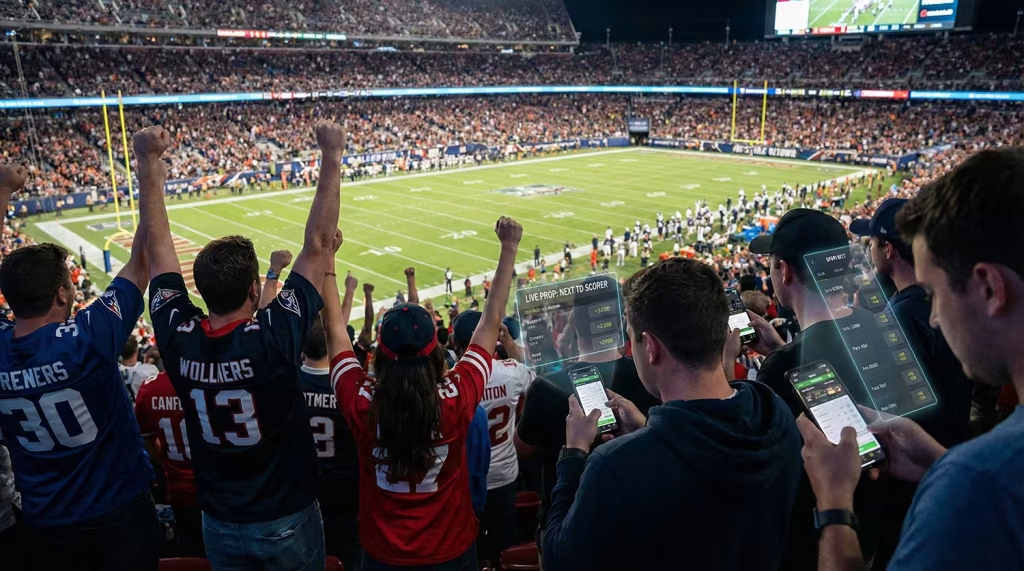
For teams and sportsbooks, in-stadium gambling looks like a win. But for fans, it’s far more complicated. The excitement is real — live betting adds a new layer of energy inside the arena — but so are the concerns about how it’s changing the live sports experience. What once felt like a communal event is slowly becoming a personalized, bet-driven experience where fans watch the same play for completely different reasons.
The Convenience Is Irresistible
Being able to bet without leaving your seat has reshaped the game-day routine. Fans can jump on:
- Next-drive bets in the NFL
- Pitch-by-pitch props in MLB
- Timeout wagers during NBA runs
- Live player props that update every few seconds
It’s instant. It’s interactive. And it’s addictive in a way that old-school betting never was.
These options turn every moment into a potential “win,” even if your team is losing on the scoreboard.
But the Pushback Is Real
Not everyone is thrilled with this direction. Some fans feel like the stadium is drifting away from what made it special — community, tradition, and pure competition. Families, especially, worry that the environment now feels commercialized and overly adult.
The recurring complaints:
- “The game feels secondary now.”
- “Everything is about apps and odds.”
- “My kids are seeing betting ads nonstop.”
- “It feels like a casino with a field attached.”
This isn’t just nostalgia talking — it’s a growing divide in what different generations expect from live sports.
Surveys Show a Deep Divide
Younger fans (Gen Z and Millennials) overwhelmingly support in-stadium betting. They see it as part of the entertainment package. But older fans and families are far more cautious. Casual fans — those who watch for fun, not wagers — say the atmosphere is shifting too quickly toward gambling obsession.
The result: stadiums are becoming a cultural battleground between those excited about modern sports entertainment and those who fear the heart of the game is being replaced by betting slips.
Why Teams & Leagues Can’t Resist the Money
If you really want to understand why stadium casinos are exploding, follow the money. Teams aren’t adding sportsbooks inside their venues because fans demanded it — they’re doing it because the financial upside is enormous and almost entirely risk-free for the franchises themselves.
In a world where media rights are plateauing and attendance is inconsistent, gambling has become the shiny new revenue engine leagues can’t afford to ignore.
Where the Cash Actually Comes From
Stadium gambling creates income on multiple fronts, many of which didn’t even exist a few years ago. For teams, these partnerships operate like a financial cheat code: sportsbooks handle the operations, and franchises enjoy the benefits.
Teams profit from:
- Licensing deals to allow sportsbooks to operate inside the stadium
- Revenue-sharing agreements on bets or food/beverage tied to betting lounges
- Massive sponsorship packages from top operators
- Premium seat upgrades connected to luxury sportsbook areas
- Year-round traffic, especially during non-game days
This mix of revenue streams gives teams something they desperately need: predictable, recurring income that doesn’t depend on wins and losses.
Why Sportsbooks Want In
Sportsbooks aren’t building these lounges for the ambience — they’re fighting for market share. In a hyper-competitive industry, physical presence inside a stadium is branding gold. Being the sportsbook inside a major arena increases trust, fan familiarity, and volume faster than digital ads ever could.
The benefits for operators include:
- Greater customer acquisition
- Stronger brand loyalty
- Higher betting frequency on game days
- A psychological edge — fans bet more when surrounded by live action
If betting is an arms race, operators want the best real estate possible. Stadiums deliver exactly that.
The Bigger Vision: Stadiums as Entertainment Districts
Teams are no longer thinking about stadiums as places where games happen. They’re thinking of them as multi-purpose entertainment hubs designed to generate revenue 24/7. Gambling is just one piece of a much bigger plan.
The long-term strategy includes:
- Casinos or casino-style gaming floors
- High-end restaurants and rooftop bars
- Esports lounges and VR experiences
- Year-round concert and event spaces
- Shopping zones tied to team brands
This shift turns a stadium from a “10 home games per year” investment into a year-round destination. Gambling is the spark that makes the economics work.
The Dark Side: Integrity, Addiction & Conflicts of Interest
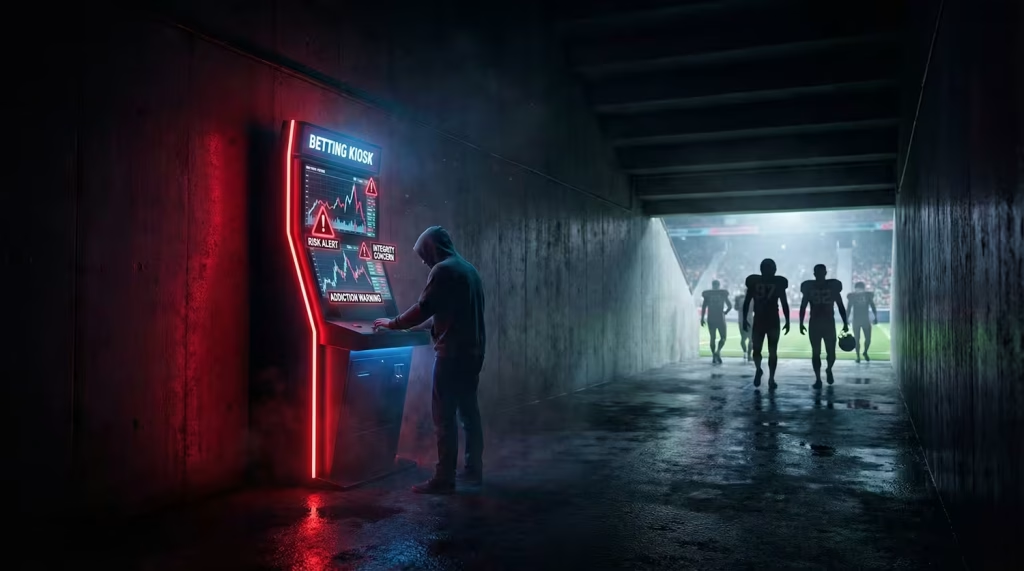
For all the excitement around in-stadium gambling, there’s a growing undercurrent of concern — and it’s getting harder for leagues to ignore. More access creates more engagement, but it also introduces more risk. In some ways, the industry is racing ahead faster than regulators, players, and even fans can process. The result is a landscape full of opportunity… and full of potential cracks in the foundation of sports.
Integrity Red Flags Are Growing
Sports have always revolved around trust — trust that the game is fair, the effort is real, and the outcome is authentic. In-stadium gambling adds pressure points that leagues were never designed to handle.
The biggest concerns:
- Micro-betting volatility: When fans can wager on individual moments, suspicious betting spikes become harder to detect.
- Player vulnerability: Fringe players with low pay and high pressure are ideal targets for manipulation.
- Emotional pressure: Athletes know that thousands of fans inside the building have money riding on every move they make.
- Recent scandals: Multiple leagues have already suspended players for gambling-related violations, proving the threat isn’t hypothetical.
The more betting moves inside stadium walls, the more leagues must walk a razor-thin line between entertainment and integrity.
Gambling Harm Concerns Are Hard to Ignore
Stadiums aren’t casinos hidden off a highway — they’re filled with families, teens, and kids experiencing the sport for the first time. Embedding gambling directly into that environment normalizes it in ways that online ads never could.
What critics fear most:
- Children being exposed to constant betting prompts
- Casual fans feeling pressured to participate
- Gambling addiction rates rising among die-hard supporters
- Stadiums becoming high-risk environments for impulsive behavior
For many fans, sports are supposed to be an escape from life’s stress — not a gateway into financial danger.
The Optics Problem for Leagues
Even if integrity remains intact, the perception of integrity matters just as much. Fans watch how leagues respond to scandals, how aggressively they market betting, and how closely teams align with sportsbook partners. When every commercial break, scoreboard animation, and jersey patch feels tied to gambling, fans start to wonder:
“Are leagues protecting competition… or protecting revenue?”
That question alone can erode trust.
The conflict of interest is obvious:
Leagues want clean competition, but they also benefit financially when betting volume increases. If a suspicious outcome triggers fan outrage, it doesn’t matter whether anything illegal happened — the credibility hit is already done.
Are We Losing the Heart of Live Sports?
As stadiums evolve into betting hubs, a deeper question hangs in the air — one that goes beyond revenue, technology, and convenience. What happens to the soul of sports when the primary focus shifts from team loyalty to betting outcomes?
Fans can feel the atmosphere changing. The cheers sound different. The tension feels different. And for many, the emotional connection that once defined live sports is starting to blur.
The Atmosphere Is Changing
There was a time when 40,000 people rose to their feet because their team needed a big play. Now, in some stadiums, those reactions are split. One group wants a touchdown. Another needs a field goal. Others are cheering for an incomplete pass because they bet the under.
The unified roar that once made stadiums magical is slowly fracturing into a dozen competing agendas.
The Rise of the Betting-First Fan
A new type of fan is emerging — one who attends games not for the team, the atmosphere, or the tradition, but for the live betting action. They’re tracking props, monitoring apps, and making rapid-fire wagers between plays.
Common behaviors inside modern stadiums:
- Fans staring at odds instead of watching the game
- Groups celebrating individual stats instead of team success
- Emotional swings tied to micro-outcomes, not the scoreboard
- Loud reactions to plays that confuse traditional fans
This isn’t necessarily “bad,” but it’s undeniably different — and it’s transforming what it means to be part of a crowd.
What Purists Fear Most
Long-time fans see a slippery slope forming. If the culture inside stadiums keeps shifting toward betting-first engagement, the essence of live sports may begin to fade.
Their biggest fears:
- Kids growing up seeing sports as a betting product, not a competition
- Leagues adjusting rules or pacing to increase betting engagement
- Moments of authentic, emotional fandom being replaced by wagering logic
- Tradition and nostalgia taking a backseat to commercial interest
Sports have always been about connection, community, and shared experience. Purists aren’t worried about technology — they’re worried about losing the moments that make being a fan deeply human.
And whether fans agree or disagree, the question is real: If betting becomes the heartbeat of stadium culture, what happens to everything that made fans fall in love with sports in the first place?
The Future Scenario: Stadiums as Hybrid Casinos

As sports betting becomes woven into the fabric of game-day culture, stadiums are quietly transforming into something entirely new. Not just venues. Not just entertainment hubs. But full-scale hybrid casinos built around live sports.
Some fans see this as an upgrade — a modern, high-tech evolution. Others see it as the moment sports drifts too far from its roots. The truth is: both futures are possible, and the path we choose today determines which one becomes reality.
The Optimistic Path: A Fan Experience Upgrade
For leagues and operators, the upside is enormous. Imagine walking into a stadium where every seat feels personalized, every moment has added depth, and technology enhances the game rather than distracts from it.
What the “future-forward” stadium could offer:
- AR betting overlays showing live odds through your phone or glasses
- Hyper-personalized offers based on your favorite teams or players
- Betting lounges that feel like luxury sports bars
- Interactive screens that let fans predict plays in real time
- Premium sections tied to exclusive betting promotions
- Faster, smarter concessions that integrate spending rewards with betting bonuses
This vision blends entertainment, technology, hospitality, and wagering into a seamless experience. To many fans — especially younger ones — this isn’t a threat. It’s an upgrade.
The Pessimistic Path: A Slow Decline
But the same transformation could go in the opposite direction — and fast. More access means more risk, more temptation, and more opportunities for the experience to shift away from sports entirely.
The worst-case version looks like:
- Stadiums that feel like casinos with fields attached
- Fans caring more about parlays than the actual game
- Frequent integrity controversies due to micro-betting
- Players facing harassment tied to betting outcomes
- Families and casual fans slowly disappearing
- A cultural divide between “betting fans” and everyone else
In this scenario, sports become secondary to the betting economy. The traditions, emotions, and shared moments that built generations of fans get overshadowed by wagering incentives and commercial pressure.
Which Way Are We Heading?
Leagues say they want balance. They talk about responsibility, integrity, and protecting fans. But the decisions being made behind the scenes — deeper partnerships, expanded betting menus, more in-stadium activations — point strongly in one direction: more gambling, not less.
The critical question isn’t whether stadium casinos will exist. They’re already here. The real question is how far leagues are willing to go before the costs outweigh the revenue.
What This Means for Bettors Right Now
As stadiums evolve into full betting environments, the game-day experience is changing most dramatically for one group: the bettors themselves. Whether you’re a casual fan tossing a few bucks on a prop or a seasoned bettor tracking every line movement, in-stadium gambling changes how you prepare, how you wager, and how you manage risk. The opportunities are bigger — but so are the temptations.
How In-Stadium Casinos Change the Betting Experience
Live sports already create emotional swings. Add gambling to that environment and the intensity multiplies. Odds move faster. Bets feel more urgent. And the social pressure around betting becomes impossible to ignore.
Here’s what bettors can expect going forward:
- More exclusive odds available only within the stadium
- Faster access to live bets as operators push micro-markets
- Higher frequency of impulse wagers, driven by the crowd and atmosphere
- Better promotions as sportsbooks fight for in-stadium dominance
- More creative bet types, especially player props and next-play predictions
- Targeted offers via geolocation, hitting your phone the moment you walk in
- Increased betting volume overall, simply because it’s so accessible
Stadium operators know the formula: excitement + convenience = more wagers. That’s why the environment is built to keep bets flowing all game long.
The Risk: Emotional Betting in a High-Energy Environment
Even smart bettors can get caught up in the moment. A loud stadium, a big crowd reaction, and the rush of live betting can trick you into thinking you’re seeing “momentum” that isn’t there. No environment increases the temptation to chase losses more than a stadium where thousands of fans are all betting at once.
Common emotional traps:
- Revenge bets after a bad beat
- Overconfidence after one win hits
- Pressure to keep up with the betting behavior of friends
- FOMO when odds shift and everyone reacts
- Chasing losses, believing the environment will “turn things around”
Recognizing these impulses is crucial for responsible betting.
Smart Ways to Stay in Control
If you want to enjoy in-stadium betting without letting it take over your night, a little structure goes a long way.
Practical tips:
- Set your unit limit before entering the stadium
- Decide your max loss and do not exceed it
- Avoid betting during emotional spikes — touchdowns, buzzer-beaters, bad beats
- Use fewer props and stick to bets with logic behind them
- Track your bets so you know where your money is going
- Take breaks from the sportsbook lounges and kiosks
- Treat betting as part of the entertainment — not the purpose of the event
In-stadium gambling can be fun, immersive, and even profitable. But the bettors who survive the long run are the ones who stay disciplined when the environment pushes them not to.
A New Era or the Beginning of the End?
Stadium casinos represent one of the biggest shifts in sports culture we’ve ever seen. On one hand, they offer innovation, excitement, and a modernized fan experience that aligns with where entertainment is heading. On the other, they raise real questions about integrity, addiction, and whether the emotional core of sports can survive when everything becomes a betting opportunity.
This isn’t a small change. It’s a fundamental rewriting of what it means to attend a game. For teams and operators, the revenue upside is enormous. For fans, the experience becomes more immersive and more intense. But with that intensity comes risk — not just financial, but cultural.
The future of stadium gambling will come down to balance. If leagues can innovate responsibly, protect fans, and preserve the heart of competition, stadium casinos could become a powerful part of the sports ecosystem. If not, the industry may find itself chasing revenue at the cost of credibility.
Because once the crowd stops cheering for the team and starts cheering only for their bets… the entire meaning of sports changes.
And that’s a gamble no league can afford to lose.
Houston Texans vs. Kansas City Chiefs Prediction & Best Bets (December 7th, 2025)
The season is on the line for the Kansas City Chiefs in week 14, as they host the Houston Texans on Sunday Night Football. Patrick Mahomes and company will be mild -188 favorites at home, but a middling 6-6 record suggests they could be flimsier bets than usual.
A huge reason for doubt is Houston’s stifling defense, which made the Buffalo Bills look human just a couple of weeks ago. The Texans have also been on fire, winning each of their last four games.
Despite their turn around, Houston still sits third in the competitive AFC South. Kansas City, meanwhile, does not have a clear path to winning the AFC West, making a win on SNF absolutely crucial to their playoff chances.
Wondering what the best bet for this game is? I’ve got three Texans vs. Chiefs picks I love. Let’s go over the latest odds and key matchups to highlight what stands out, and I’ll wrap things up with my ultimate Chiefs vs. Texans prediction.
Game Info Snapshot
- Date & Location: Sunday, December 7th, 2025 | Kickoff at 7:20 pm ET (NBC) at Arrowhead Stadium in Kansas City, MO
- Team records entering the game:
- Texans: 7-5
- Chiefs: 6-6
- Odds (from FanDuel)
- Spread: Texans +3.5 (-105) | Chiefs -3.5 (-115)
- Moneyline: Texans (+168) | Chiefs (-200)
- Total: Over 41.5 (-118) | Under 41.5 (-104)
The odds reflect the importance of this game for the Chiefs, as well as the fact that they are at home. It’s still a relatively tight spread and moneyline, however, showing bettors that the Texans are a respected threat.
The game total is extremely low, signaling the combined efforts of two very good defenses. This is suggesting a very low-scoring game that is likely going to go down to the wire.
Storylines to Watch
The biggest Chiefs vs. Texans storyline for this game is easily the decline of the mighty Chiefs. They went from playing in the Super Bowl last year to 6-6. A loss here would really hurt their playoff chances, as they already sit in third place in their own division.
There is a lot to get excited about for this game. Check out a few more key Texans vs. Chiefs storylines:
- Houston’s Elite Defense: You’re looking at the best scoring defense (16.5 ppg allowed) in all of football. But can they march into a hostile environment and finish off a Chiefs dynasty?
- Texans on Fire: Houston is red hot coming into this game, as they’ve won four straight and seven of their last nine. Arrowhead Stadium is a brutal place to play, but can they find a way to keep winning?
- End of a Dynasty?: Bigger than KC’s potential to miss the playoffs is the fact that a loss here could also mark the end of their dynasty. Could big changes be coming if they miss the playoffs this year?
Team Profiles

Houston Texans
The Texans are where they thought they’d be, but not via the path anyone expected. This was always meant to be a playoff contender, but Houston got off to a rocky 0-3 start that threatened to derail their season before it really began.
Houston was in all of those first three losses, however, while they’ve displayed a tenacious defense from the jump. DeMeco Ryans’ crew found a way to dig deep and bounce back, as they’ve gone a blistering 7-2 since that rough start.
Here’s a quick look at how they’ve stood out along the way:
- Nasty Up Front: Houston’s defensive success starts up front, where they only allow 4.0 yards per carry (10th) and just 91.7 rushing yards per game (4th). Containing the team’s rushing attacks makes them one-dimensional and easier for Houston to defend.
- Teeing Off: Playing into their stingy run defense is a disruptive pass rush. Houston owns an 8.3% sack rate, which is the 6th best in the league. Danielle Hunter (11 sacks) and Will Anderson Jr. (10.5) form one of the sickest pass rushes the NFL has to offer.
- Turnover Battle: Houston’s offense isn’t consistently elite at anything, save for taking care of the ball. The Texans only commit 0.8 giveaways per game (7th fewest), while the defense helps them play complementary football by being as opportunistic units in the league with 1.6 takeaways (5th most) per contest.

Kansas City Chiefs
Much like the Texans, Kansas City got off to an unexpectedly slow start. The Super Bowl hangover was apparently a thing, as they lost their season opener to the Chargers and fell to the Eagles the next week.
KC did manage to get it going enough to get to 5-3 at one point, but have unraveled lately during a rough 1-3 stretch that now has their season hanging in the balance.
There’s still some good that has come out of this Chiefs team, of course. Here’s a look at where they’ve excelled in 2025:
- Pass Attack: Kansas City has one of the best passing games in the league. Patrick Mahomes hasn’t been the most accurate, but he leads an offense that springs big plays (11th) and accumulates the 2nd most passing yards per game (256.5).
- Stingy Front: Kansas City doesn’t run the ball all that well, but they sure can stop it. Much like Houston, the Chiefs are quite good against the run, only allowing 100.9 yards per game on the ground (9th best).
- RZ Masters: Kansas City is top-10 in both red-zone defense and offense. Mahomes and co. finish drives inside the 20 with a score 62% of the time (10th), while their defense is even better (7th), only allowing a RZ score 54% of the time.
Key Matchups & Angles
Check out the key Texans vs. Chiefs matchups:
- Houston’s pass rush vs. Kansas City’s passing game: This is likely the key to the game. The Chiefs have dangerous weapons and Mahomes is their guiding light, but they’ll need to stave off a disruptive Texans pass rush that sacked Josh Allen 8 times a couple of weeks ago.
- Who Blinks First?: Both of these offenses are elite at protecting the football, with KC and Houston giving up the 3rd and 7th fewest turnovers. Houston may have the edge, however, as they force 1.6 takeaways per game.
- Finish the Job: If Houston wants to stage this upset on the road, they may need to show up in the RZ on both sides of the field. KC has been elite inside the RZ, but the Texans are just average defensively and atrocious (31st!) on offense.
Betting Trends & Odds Context
Take a look at the latest Texans vs. Chiefs odds, per FanDuel:
| Team | Spread | Moneyline | Total |
|---|---|---|---|
Texans | +3.5 (-102) | +168 | Over 41.5 (-118) |
Chiefs | -3.5 (-120) | -200 | Under 41.5 (-104) |
Take a look at some key betting trends for this showdown:
- Public Betting: Most everyone is siding with the Chiefs in this one, as 77% of the bets and 80% of the money is backing Kansas City.
- Record History: These two sides have only faced each other 16 times. Kansas City predictably holds an 11-5 series advantage and has won each of the last five meetings, including a 23-14 showdown in the playoffs last year.
- ATS Tidbits: Houston hasn’t been amazing (6-6) against the spread, while they are just 3-3 ATS as the favorite and 2-4 ATS on the road. Kansas City also hasn’t been reliable against the spread (5-6-1), while they are 1-1 ATS as the underdog and 4-1-1 ATS at home.
Best Bets for Texans vs. Chiefs
Pick 1: Kansas City Chiefs ML (-188) – 7/10 Confidence
Why We Like It
The Chiefs aren’t a team I like to bet against, especially at home with their season on the line. Houston’s defense is definitely tough, but KC’s offense is better than Houston’s, and KC has been at its best (5-1) at home.
Risks/What to Watch
Houston’s defense is good enough to scare anyone. It’s entirely possible they shut the Chiefs down. Besides, the Chiefs are 6-6 and a lot less reliable than usual.
Pick 2: Over 41.5 (-118) – 7/10 Confidence
Why We Like It
The total is just too low. Houston only gives up 16.5 points per game, but they’re also running into a pretty capable offense that averages 25.4 per game. The edge leans toward Kansas City at home, so I put the onus more on Houston needing to step up, rather than the Texans stifling the Chiefs on the road.
Risks/What to Watch
Defense wins championships, and we saw the Texans make Josh Allen look silly recently. They could come into Kansas City and stifle Kansas City, or a weak Houston offense could always struggle to contribute to the total.
Pick 3: Prop Play – Rashee Rice Over 70+ Receiving Yards (-114) – 7/10 Confidence
Why We Like It
This is a prop that just keeps on hitting. The matchup stinks, but Rashee Rice is a huge part of what the Chiefs do on offense. He’s topped this mark in four of his last five games.
Risks/What to Watch
Houston’s defense is very good, and they do rank 4th against the pass. If they make it their top priority to take Rice out of the game, he could have a tough time hitting this prop.
As Texans vs. Chiefs momentum shifts, changing odds lines reveal how bettors view KC’s desperation and Houston’s surge—track updated football odds at our top football betting sites.
Final Verdict: Chiefs Stay Alive, Down Texans at Home
My top Chiefs vs. Texans prediction is that Patrick Mahomes and co. come through in the clutch at home. The matchup is not an easy one, but it’s not as if Houston has been the most trustworthy team in the world.
Kansas City has stumbled of late, but all three of their recent losses came on the road and were by one score. Two of them were against legit playoff teams in Buffalo and Denver.
The Texans might be a legit contender, but they will have to prove it. Step one is beating a desperate Chiefs team in front of their home crowd, and I predict they will fail.
Alternatively, this game total is very low, and Rashee Rice keeps racking up receiving yardage. I’ll gladly bet on the Over and trust in Rice’s role in what should be an entertaining performance on Sunday Night Football.
Final Score Prediction: Chiefs 24, Texans 20
Pittsburgh Steelers vs. Baltimore Ravens Prediction & Best Bets (December 7th, 2025)
The battle for the AFC North division crown commences on Sunday, where the Baltimore Ravens will be -280 favorites to down the rival Pittsburgh Steelers at home.
Pittsburgh originally raced out to an impressive 4-1 start while an injury-ravaged Ravens team struggled (1-5), but both teams are now 6-6 and face off with the division on the line.
This game is crucial for both sides, especially with the Cincinnati Bengals also breathing down their necks. A loss here may signal an exit from the AFC playoff conversation, while a win would give the victor a leg up in the race for the AFC North title.
Not sure who to back? Let’s analyze the latest odds and key matchups as I hand out my top picks and a Steelers vs. Ravens prediction.
Game Info Snapshot
- Date & Location: Sunday, December 7th, 2025 | Kickoff at 1:00 pm ET (CBS) at M&T Bank Stadium in Baltimore, MD
- Team records entering the game:
- Steelers: 6-6
- Ravens: 6-6
- Odds (from DraftKings)
- Spread: Steelers +5.5 (-104) | Ravens -5.5 (-118)
- Moneyline: Steelers (+235) | Ravens (-290)
- Total: Over 43.5 (-105) | Under 43.5 (-115)
Pittsburgh comes in as clear underdogs on the road, as they have not been in good form, and Baltimore has been white hot after a rough start.
The game total is quite low, factoring in Pittsburgh’s dormant offense and a much improved Ravens defense.
Storylines to Watch
The main Steelers vs. Ravens storyline is the fact that this game is for sole possession of first place in the AFC North. It’s quite likely the winner of this game will go on to win the division, although the two sides will meet again one more time before the year is up.
Here’s a look at some other key Ravens vs. Steelers storylines to keep in mind:
- Rested Lamar: Lamar Jackson has not looked like himself in recent weeks, but he last played on Thursday and has had ample time to heal his body. Could we see the most refreshed and healthy version of Lamar that we’ve seen since earlier in the year?
- Pointing Fingers: Aaron Rodgers has been wrapped up in more negativity than positivity lately, as he’s publicly called out some of his teammates. Will that move backfire, or will it light a fire under his crew?
- Sulking Defense: Pittsburgh’s defense has tons of star power, but the results have been inconsistent. Can they rise to the challenge with the season arguably on the line, or will a week 14 loss to their rivals be the last straw in a disappointing season?
Team Profiles

Pittsburgh Steelers
The Steelers have been an interesting team, but arguably a fairly fraudulent one. They won a shootout with the Jets back in week one, while their offense carried the team en route to a 4-1 start.
A crazy 33-31 shootout loss to the Bengals in week six probably should have been the writing on the wall – and perhaps it was – as the Steelers have struggled to be consistent during a brutal 2-5 stretch after that hot start.
The Steelers don’t defend well, and their offense is like pulling teeth. However, they do stand out in some key areas:
- Finish the Job: Pittsburgh isn’t as balanced or productive as you’d like as a whole on offense, but they do a good job when they get inside the 20. Aaron Rodgers and co. know how to finish a series, converting in the red zone at a 65.7% rate – 6th best in the NFL.
- Pressure Up Front: The Steelers aren’t as nasty on the edge as they usually are, but T.J. Watt and co. can still bring the heat. They are in the middle of the pack (15th) with a 6.9% sack rate so far in 2025.
- Turnover Margin: Aaron Rodgers turns the ball over more than he has historically, but the Steelers are so good at taking the ball away (2nd) that it can negate their offensive struggles. The Steelers happen to own the league’s 5th-best turnover margin per game.

Baltimore Ravens
The Ravens have endured a trying season, as they had a win wrapped up in week one against the Bills, but unraveled late in a loss. They bounced back with a blowout win over the Browns in week two, but proceeded to have major issues on defense during a 1-5 start.
An injury to star quarterback Lamar Jackson contributed to that rough stretch, but Baltimore’s defense calibrated, and Jackson eventually returned to the lineup. Baltimore has combined improved defense and Lamar’s return to go 5-1 in their last five games, and they figure to keep it rolling at home against Pittsburgh.
Here’s a quick look at where they’ve excelled in 2025:
- Ground Control: Lamar Jackson hasn’t been carrying much of the load with his legs lately, but this is still a team that likes to run and is quite good at it. Derrick Henry spearheads a Ravens offense that is third in yards per rush (5.0) and 4th in rushing yards per game (136.8).
- Splash Plays: In addition to a strong rushing attack, Baltimore still reserves the right to hurt you deep. Guys like Isaiah Likely, Mark Andrews, and Zay Flowers have delivered chunk plays throughout the year, helping Baltimore rank 8th in yards per pass (7.6).
- Bend, Don’t Break: Baltimore’s defense has given up production for much of the year, but they typically batten down the hatches when opposing offenses get close. They are only giving up a RZ score 54% of the time, which ranks 6th in the NFL.
Key Matchups & Angles
Check out the key Steelers vs. Ravens matchups:
- Steelers passing offense vs. Ravens passing defense: Pittsburgh weirdly loves to throw the ball, but they’re not that good at it. Baltimore ranks 31st in sack rate and 26th against the pass, though. This is actually a spot where the Steelers might be able to find success.
- Ravens rush offense vs. Steelers run defense: Baltimore is going to run all day if you let them. Pittsburgh prefers you to throw, but if they can’t force it, they struggle to the tune of 4.3 yards per carry allowed (18th). Derrick Henry could dominate in this matchup if Baltimore can play with a lead.
- Red-Zone Battle: Pittsburgh has been quite good at finishing scoring drives, while this Ravens defense doesn’t allow much scoring inside the 20. Something has to break, or the Steelers need to find a way to score before they enter the RZ.
Betting Trends & Odds Context
Take a look at the latest Steelers vs. Ravens odds, per FanDuel:
| Team | Spread | Moneyline | Total |
|---|---|---|---|
Steelers | +5.5 (-104) | +235 | Over 43.5 (-105) |
Ravens | -5.5 (-118) | -290 | Under 43.5 (-115) |
Take a look at some key betting trends for this showdown:
- Public Betting: The public loves Baltimore in this spot, as the Ravens are getting 83% of the bets and 80% of the money right now.
- Record History: This is a storied rivalry with these division rivals meeting 63 times already. Baltimore won both meetings last year with ease, while the Steelers won the four matchups before that.
- ATS Tidbits: Pittsburgh (5-7) has been weak against the spread, while they are 2-1 ATS in division games, 2-4 ATS as the underdog, and 1-4 ATS on the road. Baltimore (4-8) is even worse, as they are just 4-6 ATS as the favorite, 2-3 as the home favorite, and 1-2 ATS inside the AFC North.
Best Bets for Steelers vs. Ravens
Pick 1: Baltimore Ravens ATS -5.5 (-118) – 7/10 Confidence
Why We Like It
The Ravens have been the much more cohesive team lately and were a trendy Super Bowl pick before the season started. They got tripped up by the Bengals, but they’re at home and will be focused on bouncing back.
Risks/What to Watch
Pittsburgh has still been largely competitive in 2025 and has some surprising wins like a defeat of the Colts not too long ago. They’ve wilted in high-profile matchups lately, but they could always flip the script against a familiar foe.
Pick 2: Under 43.5 (-120) – 7/10 Confidence
Why We Like It
Pittsburgh has a ball-control offense that is not very explosive, while the Ravens like to run a good amount. Given Baltimore’s improved defense and the magnitude of this game, we could see a heightened effort on defense for both sides in a tight, low-scoring affair.
Risks/What to Watch
Baltimore had one of the best offenses in football before Lamar Jackson got hurt. The Steelers also give up over 24 points per game. If the damn breaks, the Ravens could run away with this one.
Pick 3: Prop Play – Lamar Jackson Anytime TD (+270) – 6/10 Confidence
Why We Like It
The extra time off should allow Jackson to get closer to 100%, which means he could be more effective on the ground. Pittsburgh is tied for the third most rushing scores allowed to QBs in 2025.
Risks/What to Watch
Jackson may not be himself fully yet, and the Steelers could go out of their way to contain him. Derrick Henry is also a TD machine (-160 to score), and he could steal the rushing opportunities inside the RZ.
As AFC North stakes rise, shifting odds lines reflect how bettors react to the Steelers vs. Ravens momentum swings—track updated football odds at our top football betting sites.
Final Verdict: Ravens Take Over the AFC North
My main Ravens vs. Steelers prediction is that Baltimore is going to win this game. The issue is their moneyline is pretty hefty at -280. That’s something you could go harder at individually or throw on your favorite parlay for the week, but it lacks high-end value.
You can obtain value by betting on the Ravens to cover the 5.5 spread. They’re the better team, Pittsburgh has been blown out twice in their last four games, and with so much on the line, I expect the Ravens to leave little doubt.
That said, the Steelers may still come to play and keep it close and low-scoring – at least initially. Historically, these battles have been kind of gross, so while I very much lean toward the Ravens, the overall scoring should be fairly limited.
Lastly, I love the value with Lamar finding the endzone with his legs. It’s a riskier Steelers vs. Ravens prop bet, but there is clear upside, and this is something Jackson has done regularly in his career.
Final Score Prediction: Ravens 20, Steelers 10
